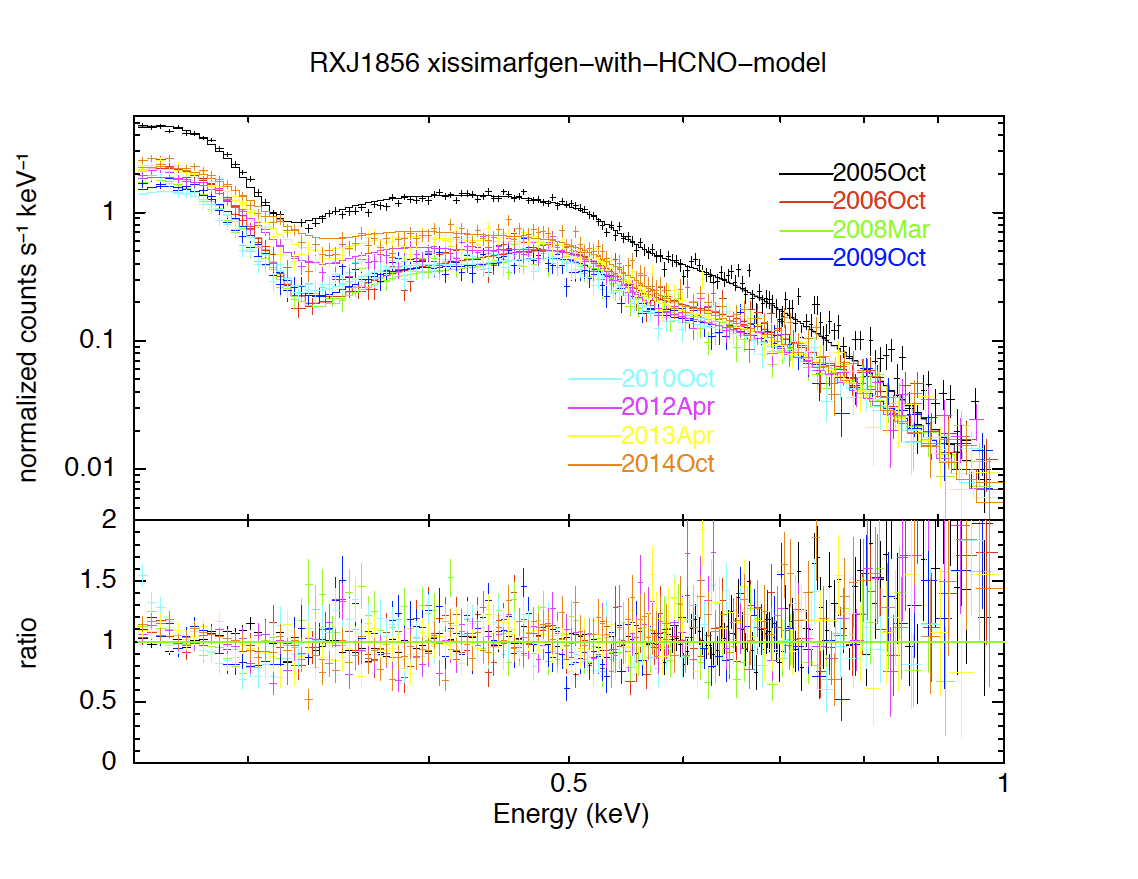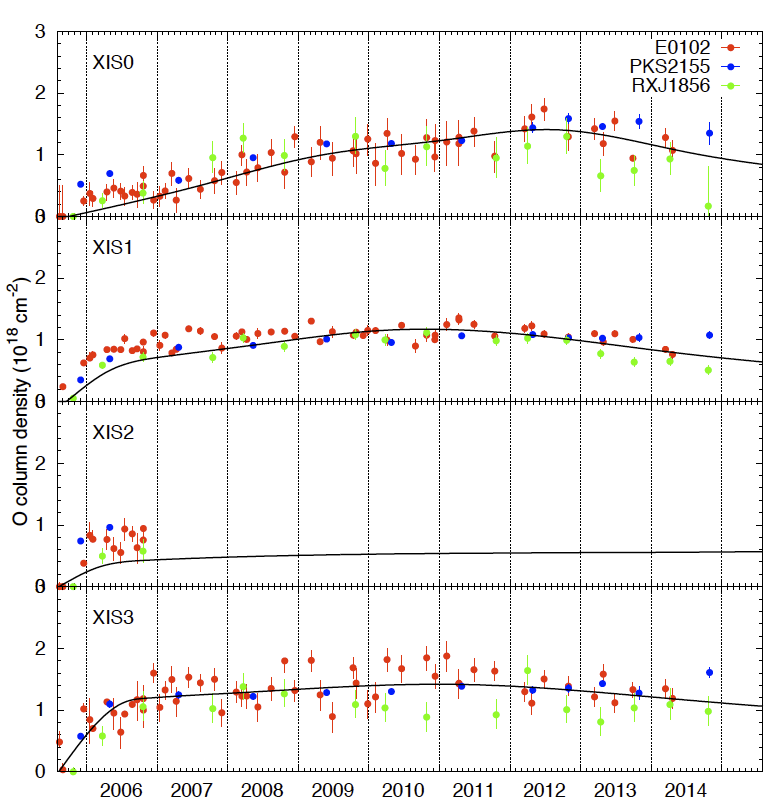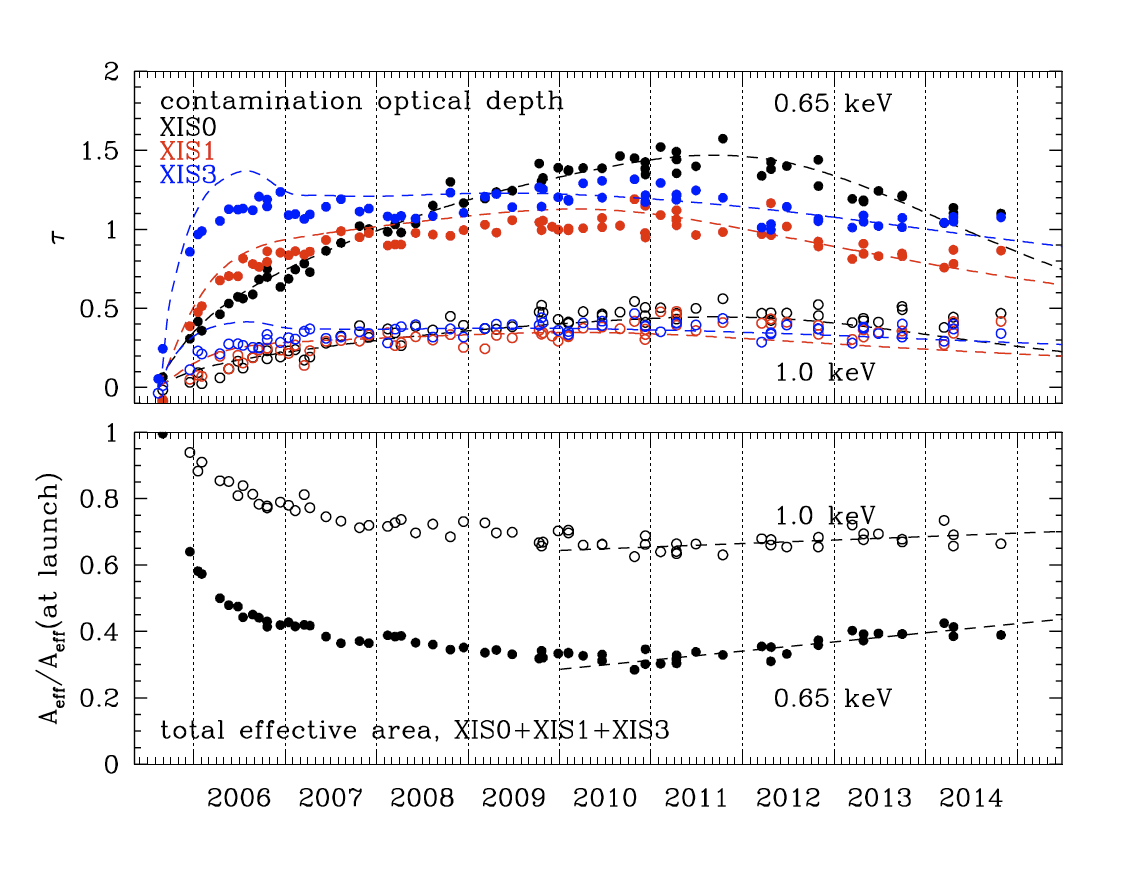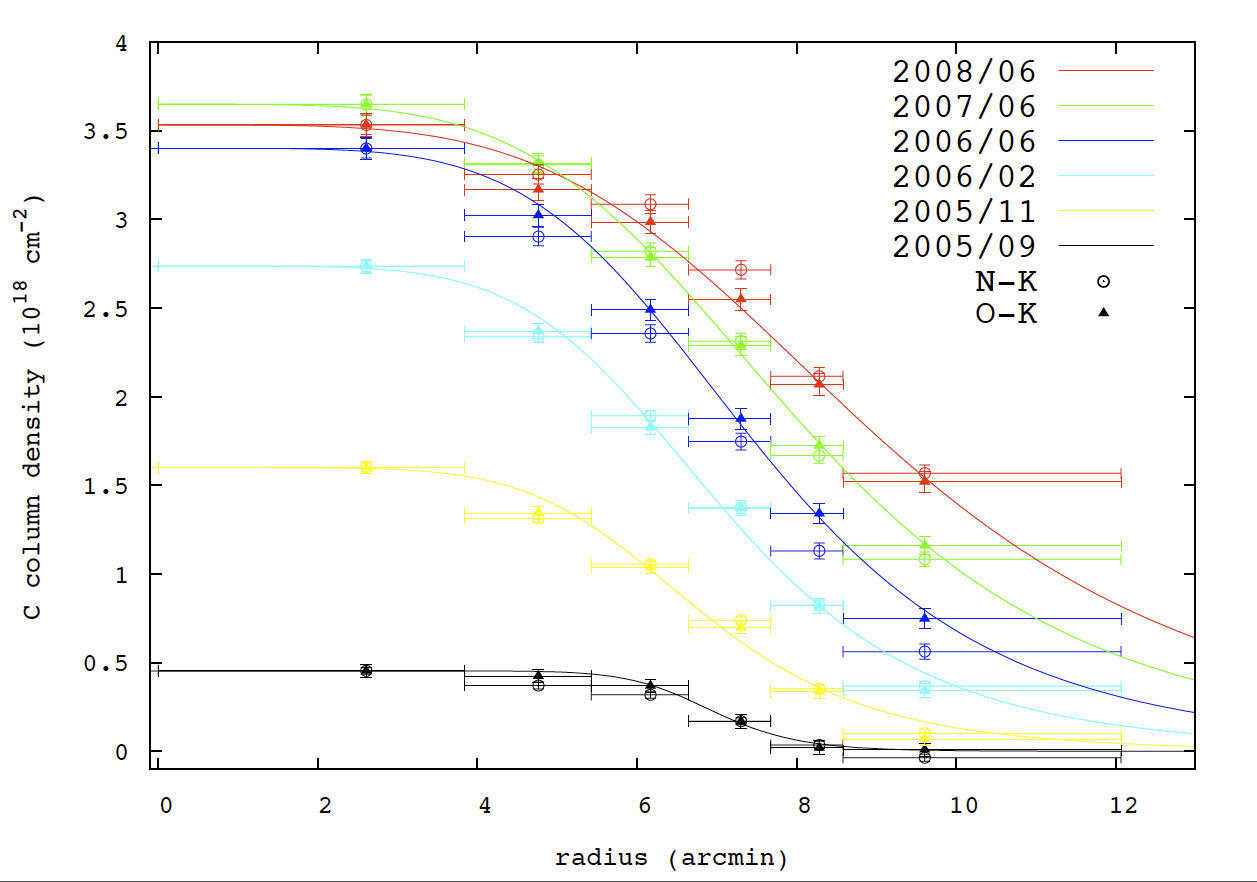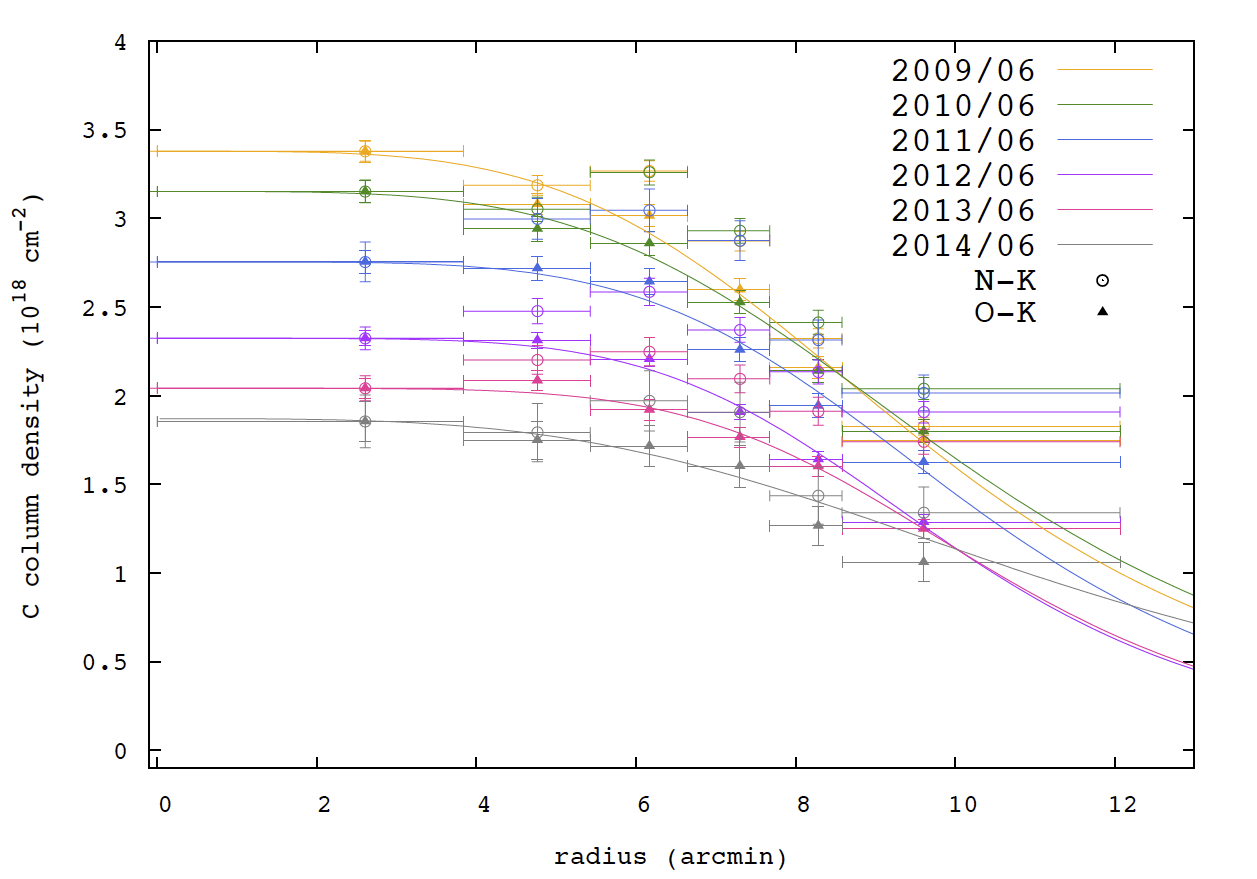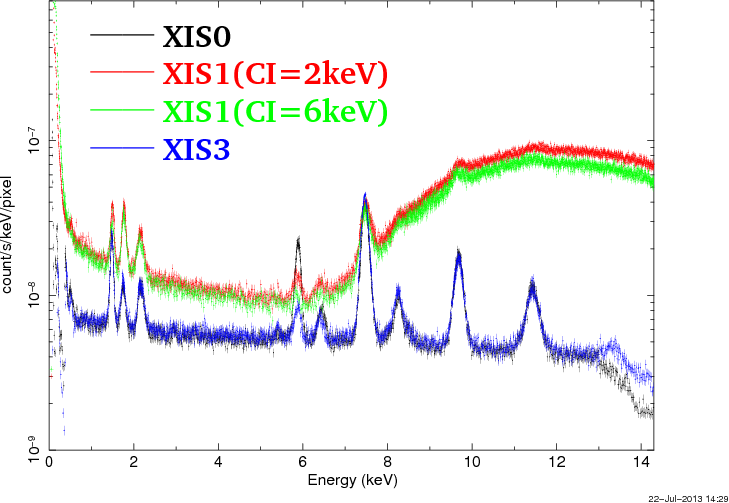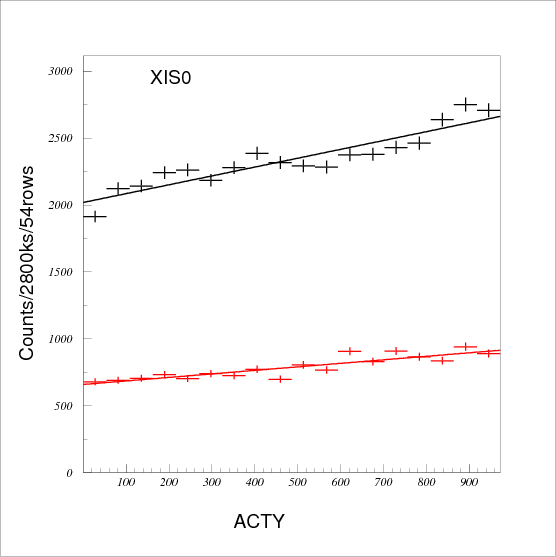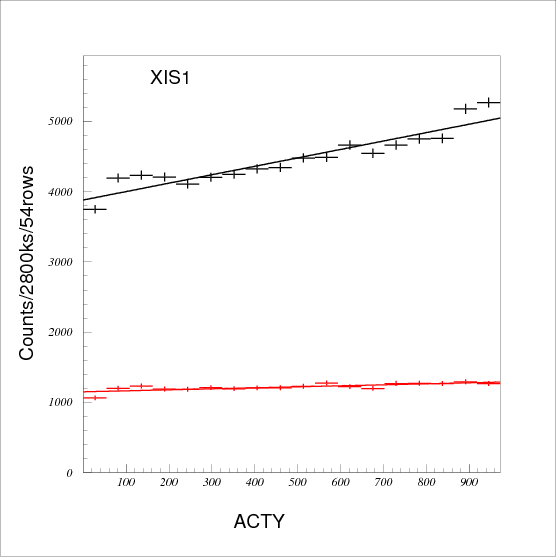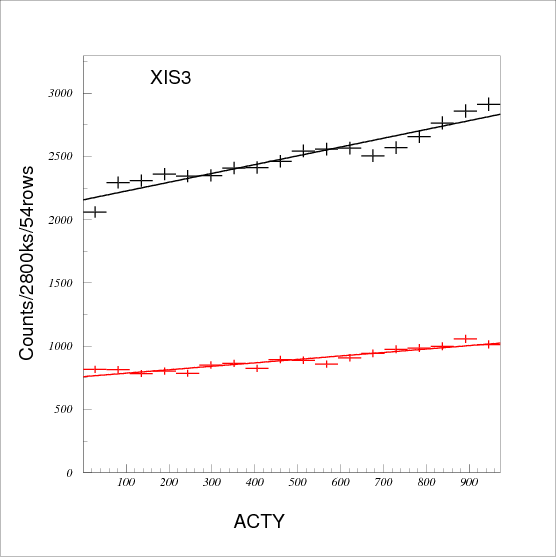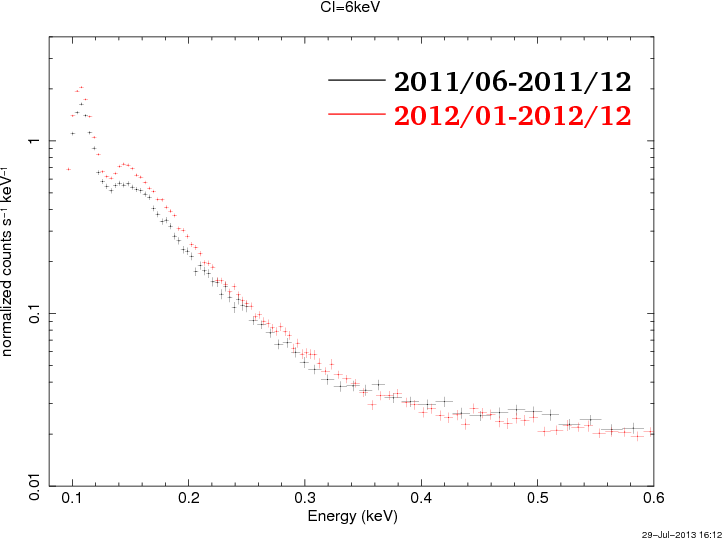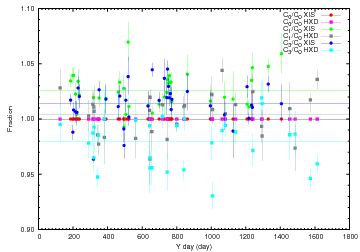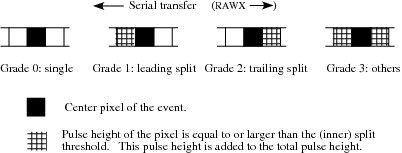



Next: Bibliography
Up: Suzaku Technical Description
Previous: 6. X-Ray Telescopes (XRT)
Contents
Subsections
7. X-Ray Imaging Spectrometer (XIS)
7.1 XIS Overview
7.1.1 XIS Basics
The X-ray Imaging Spectrometer (XIS, Koyama et al., 2007) celebrated its
first light on 2006, August 11, about a month after the launch of
Suzaku. The instrument has been operated successfully since
then, producing many scientific results. The entire instrument has a
weight of 48.7kg and consumes 67W at a bus voltage of 50V during
normal operations. The XIS is composed of four units of Si-based X-ray
charge coupled device (CCD) cameras (Fig. 7.1). In these
X-ray sensors, incident X-ray photons are converted into a number of
electron-hole pairs via photoelectric absorption and subsequent
ionization by photoelectrons and their secondaries. The energy of the
incident photon can be measured since it is proportional to the amount
of charge produced.
Each XIS unit is located at the focal plane of one of four
independent, identical, and co-aligned X-Ray Telescope modules
(XRT, Serlemitsos et al., 2007), which are called XRT-I0, XRT-I1,
XRT-I2, and XRT-I3. The XIS is operated in photon-counting mode, in
which each X-ray event is discriminated from the others and its
position, energy, and arrival time are reconstructed. This gives the
XIS imaging-spectroscopic capabilities in the 0.2-12.0keV energy
band over an
 region.
region.
Figure 7.1:
A photo of one of the four XIS
sensors before installation on the satellite.
|
|
The XIS is similar to its predecessor, the Solid-state Imaging
Spectrometer (SIS) onboard the ASCA satellite, in its working
principle. Many improvements were made based on successful use of the
SIS over eight years. It is also similar to its brothers: Chandra
ACIS (Garmire et al., 2003), XMM-Newton EPIC (Turner et al., 2001; Strüder et al., 2001), and
Swift XRT (Burrows et al., 2004).
X-ray CCD instruments, including the XIS, are characterized by their
flexibility in operation and possible rapid performance changes on
orbit. In particular, micro-meteorite hits can leave unrecoverable
damage to a part of the instrument. The entire imaging area of the
XIS2 was lost in 2005 November and a part of the XIS0 in 2009 June.
The XIS has several advantages over other instruments.
- The XIS is suited to investigate extended emission of low
surface brightness for the following reasons:
- It has a low and stable background environment through a
combination of the low Earth orbit of the satellite and the
instrument design.
- It has a large effective area, which is comparable to the EPIC
in the Fe K band.
- The energy resolution and gain are well calibrated over the
entire chip.
- The XIS is more tolerant regarding pile-up when observing bright sources
for the following reasons:
- The PSF of the XIS is much larger than those of ACIS and EPIC
while the plate scale is comparable. This means a heavy
oversampling of the PSF.
- It has a wide range clocking mode options provided as user options.
- Together with the HXD, simultaneous wide-band spectral coverage
is available.
The XIS was developed and has been maintained jointly by Japan and the
United States, with participating organizations including the MIT,
ISAS, Kyoto University, Osaka University, Rikkyo University, Ehime
University, Miyazaki University, Kogakuin University, Nagoya
University, Aoyama Gakuin University, and major participating
contractors including the Mitsubishi Heavy Industries (MHI), the
NEC-Toshiba Space Systems, and the System Engineering Consultation
(SEC) Co. Ltd.
7.1.2 XIS Components
7.1.2.1 Sensors
Each CCD camera has a single CCD chip, which consists of the imaging
area and the frame store area. The imaging area is exposed to the sky
for observations, while the frame store area is shielded. Each chip is
composed of four segments called segment A, B, C, and D. Each segment
has its own readout node (Fig. 7.3).
Figure 7.2:
Field of view of the XIS. All sensors
are co-aligned.
|
|
The imaging area has a pixel size of 1024 1024 pixels. The
pixel scale is 24
1024 pixels. The
pixel scale is 24 m pixel
m pixel and the physical size is 25mm
squared. The plate scale is 1.04
and the physical size is 25mm
squared. The plate scale is 1.04
 pixel
pixel and the
total sky coverage is 18
and the
total sky coverage is 18 squared.
squared.
Figure 7.3:
Schematic view of the data flow in one XIS unit.
|
|
The XIS1 is a back-side illuminated (BI) chip. The other three sensors
(XIS0, 2, and 3) are front-side illuminated (FI) chips. The BI and FI
chips are superior to each other in the soft and hard band responses,
respectively.
X-ray CCDs are also sensitive to optical and UV photons. To suppress
such signals, an optical blocking filter (OBF) is installed on the
surface of the CCDs. The OBF is made of polyimide with a thickness of
1000Å, which is coated with a total of 1200Å of Al (400Å on one side and 800Å on the other).
For in-flight calibration, three  Fe calibration sources with a
half life of 2.73 years are installed in each XIS unit. The
Fe calibration sources with a
half life of 2.73 years are installed in each XIS unit. The  Fe
sources emit strong Mn K
Fe
sources emit strong Mn K and K
and K lines at 5.9keV and
6.5keV, respectively. Two sources illuminate corners of the segments
A and D of the imaging area at the far side of the readout node. The
other one is installed in the door. It was used to illuminate the
entire chip before opening the door for the final check before launch
and the initial check after launch. Because the door was opened for
observations, the door calibration sources are not used any
longer. Scattered X-rays from the door calibration sources may appear
in the entire imaging area.
lines at 5.9keV and
6.5keV, respectively. Two sources illuminate corners of the segments
A and D of the imaging area at the far side of the readout node. The
other one is installed in the door. It was used to illuminate the
entire chip before opening the door for the final check before launch
and the initial check after launch. Because the door was opened for
observations, the door calibration sources are not used any
longer. Scattered X-rays from the door calibration sources may appear
in the entire imaging area.
7.1.2.2 Cooling System
To reduce the dark current, the sensors are kept at  C
all the time. Thermo-electric coolers (TECs) using the Peltier effect
are used for cooling, which are controlled by the TEC Control
Electronics (TCE).
C
all the time. Thermo-electric coolers (TECs) using the Peltier effect
are used for cooling, which are controlled by the TEC Control
Electronics (TCE).
7.1.2.3 Electronics
The analog electronics (AE) system drives the CCD by providing driving
clocks for exposure and charge transfer, sampling the voltage,
amplifying the data, and converting to the digital values. The XIS has
two identical units of the AE and the TCE (see 7.1.2.2, Cooling
system control), which are stored in the same housing for each
unit. One unit (AE/TCE01) is used for XIS0 and XIS1, while the other
(AE/TCE23) is used for XIS2 and XIS3.
The digital electronics (DE) system processes the digitized data. The
DE has two pixel processing units (PPU01 and PPU23) and a main
processing unit (MPU). The digital data from the AE are stored in the
Pixel RAM of the PPUs; PPU01 for data taken with AE/TEC01 and PPU23
for AE/TEC23. The PPUs access the raw CCD data in the Pixel RAM, carry
out event detection, and send event data to the MPU. The MPU edits the
telemetry packets and sends them to the satellite's main digital
processor.
7.1.3 CCD Pixels & Coordinates
Pixel data collected in each segment are read out from the
corresponding readout node and sent to the Pixel RAM. In the Pixel
RAM, pixels are given RAW X and RAW Y coordinates for each segment in
the order of the readout, such that RAW X values are from 0 to 255 and
RAW Y values are from 0 to 1023. These pixels in the Pixel RAM are
named active pixels. In the same segment, pixels closer to
the read-out node are read out earlier and stored in the Pixel RAM
earlier. Hence, the order of the pixel read-out is the same for
segments A and C, and for segments B and D, but different between
these two segment pairs, because of the different locations of the
readout nodes. In Fig. 7.3, numbers 1, 2, 3 and 4
marked on each segment and the Pixel RAM indicate the order of the
pixel read-out and the storage in the Pixel RAM. In addition to the
active pixels, the Pixel RAM stores copied pixels,
dummy pixels and H-over-clocked pixels
(Fig. 7.3). At the borders between two segments, two
columns of pixels are copied from each segment to the other. Thus
these are named copied pixels. Two columns of empty dummy pixels are
attached to the segments A and D. In addition, 16 columns of
H-over-clocked pixels are attached to each segment.
Actual pixel locations on the chip are calculated from the RAW XY
coordinates and the segment ID during ground processing. The
coordinates describing the actual pixel location on the chip are named
ACT X and ACT Y coordinates (Fig. 7.3). It is
important to note that the RAW XY to ACT XY conversion depends on the
on-board data processing mode.
7.1.4 Major Events
The detector performance changes both continuously and discontinuously
over time. This is especially the case for CCD instruments. Users need
to take the latest information into account in order to make the best
use of the instrument. Some major changes and their causes are:
- Continuous degradation of the gain and energy resolution by
increasing charge transfer inefficiency due to radiation damage.
- Continuous degradation of low-energy efficiency due to accumulating
contaminating material on the optical blocking filter.
- Discontinuous change of the non X-ray background due to solar
flares.
- Discontinuous change of the gain and energy resolution by
applying the charge injection operation with changing settings.
- Discontinuous loss of a part of the detector performance due to
micro-meteorite hits.
- Discontinuous change of the detector performance due to policy
changes with respect to operations in order to keep up with the
changes above and others.
Table 7.1 shows major events since the start of the mission in
chronological order. The XIS log at http://www.astro.isas.jaxa.jp/suzaku/log/xis/
gives a complete list of events relevant for data reduction.
![\begin{landscape}
% latex2html id marker 2868\begin{table}[hp]
\centering
\...
...ased for damaged area.\\
%
\hline
\end{longtable} \end{table}\end{landscape}](img149.png)
7.2 XIS Observation Planning
7.2.1 User Options
The XIS has numerous instrumental settings, which are fine-tuned to
serve a wide range of observational purposes. A few of them are left
as user options. Different options can be used for different sensors.
- Clocking mode
- Editing mode
- PPU ratio
- Lower event threshold
- Area discrimination
In many cases, the default settings are adequate. If this is not the
case, the appropriate choice of clocking mode options is generally
enough and there is little need to change the other options. The
choice between the XIS and HXD nominal positions is no longer
available: all observations are made at the XIS nominal position (the
center of the XIS field of view) unless otherwise requested.
Users need to consider an appropriate choice of clocking mode options
when they are planning observations of bright ( 10mCrab in
0.5-10keV) sources or those requiring a higher temporal resolution
than 8s.
10mCrab in
0.5-10keV) sources or those requiring a higher temporal resolution
than 8s.
Use of non-default options should be stated clearly in the technical
justification of the proposal document. The choice of clocking mode
needs to be specified in the cover page. These choices can be
tentative. For successful proposals, an inquiry is sent to the PI
about three weeks prior to the observation. The choice of user options
can be revised at this time.
The behavior of very bright sources is often unpredictable. The XIS
operation team waits until the last minute before finalizing the
options, if necessary. The deadline is 10:00 JST (1:00 in UT) every
weekday and Saturday, at which the operation team starts generating
the command sequence. Users need to submit the final choice of options
by this deadline 1-3 days before the start of their
observation. Prior consultation with the XIS operation team is
necessary for their availability and the exact deadline.
The appropriate choice of options is the responsibility of the
observer. A summary is provided by the XIS quick reference
at:
http://www.astro.isas.jaxa.jp/ tsujimot/pg_xis.pdf
tsujimot/pg_xis.pdf
The
XIS operation team can be consulted
at:
xisope@astro.iasa.jaxa.jp
The team will make the best
use of the operational flexibility to maximize the scientific output
of the observations.
7.2.1.1 Clocking Modes
The clocking mode specifies how the CCD pixels are read out. Each
clocking mode has its own  -code, a pattern of voltage clocking
for exposure and charge transfer. It enables full read, partial read,
or stacked read (Table 7.2). With a partial or
stacked read, a higher pile-up limit and timing resolution can be
achieved at a sacrifice of observing efficiency and imaging
information.
-code, a pattern of voltage clocking
for exposure and charge transfer. It enables full read, partial read,
or stacked read (Table 7.2). With a partial or
stacked read, a higher pile-up limit and timing resolution can be
achieved at a sacrifice of observing efficiency and imaging
information.
Table 7.2:
Clocking modes
| |
There are two major types of clocking mode: the Normal mode and the
P-sum mode. The Normal mode is for timed-exposure readout. It
can be combined with a window option (partial readout in space), burst
option (partial readout in time), or both (partial readout in both
space and time). Fig. 7.4 shows the time sequence of
exposure, frame-store transfer, readout, and storage to the Pixel RAM
(in the PPU) for the Normal clocking mode. The P-sum mode is
for stacked readout. The P-sum clocking mode is in principle available
for all FI sensors. However, because it is severly affected by leaked
charge in areas damaged by micrometerorite hits, the P-sum clocking
support was terminated for the XIS2 and XIS0. Therefore, it is
currently available only for the XIS3. Observers using the P-sum
clocking mode for the XIS3 need to use a Normal clocking mode for the
other sensors.
Figure 7.4:
Time
sequence of the exposure, transfer, and readout. For the window
option, 1/4 window is assumed.
|
|
- No option: full readout of all pixels with a frame time of 8s.
- Window option: partial readout in space. In the 1/
 window
mode, the central 1024/
window
mode, the central 1024/ pixels are read out in the Y direction
and the entire pixels are read out in the X direction, yielding a
1024
pixels are read out in the Y direction
and the entire pixels are read out in the X direction, yielding a
1024 1024/
1024/ pixel image. The exposure time is 8/
pixel image. The exposure time is 8/ s.
s.
- Burst option: partial readout in time. In the
 s burst mode,
all pixels are read out, but the effective exposure time is limited
to
s burst mode,
all pixels are read out, but the effective exposure time is limited
to  s (
s ( 8s). During 8s of exposure time, events detected
in the first (
8s). During 8s of exposure time, events detected
in the first ( )s are transfered and discarded without being
recorded. Events detected in the remaining
)s are transfered and discarded without being
recorded. Events detected in the remaining  s are transfered and
recoreded.
s are transfered and
recoreded.
- Window
 burst option: partial readout in both time and
space. In 1/
burst option: partial readout in both time and
space. In 1/ window and
window and  s burst mode, the central
1024
s burst mode, the central
1024 1024/
1024/ pixel image is read out with an exposure time of
8/
pixel image is read out with an exposure time of
8/ s. During the exposure time, events in the first (
s. During the exposure time, events in the first ( )s
are discarded and those in the last
)s
are discarded and those in the last  s are recoreded. The
inequity of 8/
s are recoreded. The
inequity of 8/ always holds.
always holds.
The available window and burst options are summarized in
Table 7.3.
Table 7.3:
Window and burst options (XIS nominal position)
| |
- The observing efficiency is always smaller than 1 for window,
burst, or both options due to their partial readout nature. The
efficiency can be very small.
- In the window mode, a part of the events falls outside of the
window. With a half-power diameter of 2
 and the telescope
wobbling of
and the telescope
wobbling of  0.5
0.5 , this is not negligible especially
for
, this is not negligible especially
for  with 2.2
with 2.2 for the window height and for the XIS1
with the wobbling direction perpendicular to the window. The
telescope wobbling is synchronous to the rotation period of the
satellite of
for the window height and for the XIS1
with the wobbling direction perpendicular to the window. The
telescope wobbling is synchronous to the rotation period of the
satellite of  96 min, which gives an artificial fluctuation in
the count rate with this frequency.
96 min, which gives an artificial fluctuation in
the count rate with this frequency.
- The window mode does not include the
 Fe calibration
sources at the top corners, so self-calibration of gain and energy
resolution using the calibration sources cannot be used.
Fe calibration
sources at the top corners, so self-calibration of gain and energy
resolution using the calibration sources cannot be used.
- The observing efficiency is always larger for the 1/
 and
and
 s burst mode over the
s burst mode over the  s burst mode.
s burst mode.
- In short burst modes, out-of-time events are non-negligible.
- It is always helpful to retrieve archive data taken in the same
clocking mode as a planned observation to evaluate its
properties. The Suzaku XIS log at
http://darts.isas.jaxa.jp/astro/suzaku/suzakuxislog/top.do
can be used to find an appropriate observation.
The pulse height from 128 rows are stacked into a single row along the
Y direction. Charge is transferred continuously, thus the spatial
information along the Y direction is lost and replaced with the
arrival time information. The arrival time is ticked at a 7.8ms
resolution. This is smeared by the point spread function with a HPD of
2 , which is equivalent to 0.9s.
, which is equivalent to 0.9s.
7.2.1.2 Editing Modes
The editing mode specifies the telemetry format of the events. The XIS
has several editing modes (Table 7.4). Four of
them are for observational purposes, the remaining ones are for
diagnostic purposes.
Table 7.4:
Editing modes and size per event for observation modes
| |
For Normal clocking modes three editing modes (5 5, 3
5, 3 3,
and 2
3,
and 2 2) are available. The 2
2) are available. The 2 2 mode is used only for
the FI sensors. For P-sum clocking mode, the editing mode is fixed to
the timing mode. Each editing mode has a different telemetry format,
which includes the x and y position and the pulse height (PH) of the
event (Fig. 7.5). Different editing modes have
different sizes per event (Table 7.4).If the
dark-subtracted PH value is above the split threshold in the
neighboring pixels, they are considered to be a part of the charges
generated by the event and thus are summed in the event
reconstruction. Different thresholds are applied for the immediately
neighboring pixels (inner split threshold) and those around them
(outer split threshold).
2 mode is used only for
the FI sensors. For P-sum clocking mode, the editing mode is fixed to
the timing mode. Each editing mode has a different telemetry format,
which includes the x and y position and the pulse height (PH) of the
event (Fig. 7.5). Different editing modes have
different sizes per event (Table 7.4).If the
dark-subtracted PH value is above the split threshold in the
neighboring pixels, they are considered to be a part of the charges
generated by the event and thus are summed in the event
reconstruction. Different thresholds are applied for the immediately
neighboring pixels (inner split threshold) and those around them
(outer split threshold).
Figure 7.5:
Data pattern for 5 5, 3
5, 3 3, and
2
3, and
2 2 editing modes. 1-bit information indicates whether the
pulse height of the pixel exceeds the outer split threshold.
2 editing modes. 1-bit information indicates whether the
pulse height of the pixel exceeds the outer split threshold.
|
|
- 5
 5 mode: The PH values of each 5
5 mode: The PH values of each 5 5
5 25 pixel around the event center
are sent to the telemetry.
25 pixel around the event center
are sent to the telemetry.
- 3
 3 mode: The PH values of each 3
3 mode: The PH values of each 3 3
3 9 pixel around the event
center and the 1-bit information (whether the PH is larger than the outer
split threshold or not) for the surrounding 16 pixels are sent to the
telemetry.
9 pixel around the event
center and the 1-bit information (whether the PH is larger than the outer
split threshold or not) for the surrounding 16 pixels are sent to the
telemetry.
- 2
 2 mode: The PH values of each 2
2 mode: The PH values of each 2 2
2 4 pixel around the event
center and the 1-bit information (whether the PH is larger than the outer
split threshold or not) for the attached 8 pixels are sent to the
telemetry. The 2
4 pixel around the event
center and the 1-bit information (whether the PH is larger than the outer
split threshold or not) for the attached 8 pixels are sent to the
telemetry. The 2 2 pixels are selected such that they include the
pixels with the highest, the second highest, the third highest (,and the
fourth highest) PH values.
2 pixels are selected such that they include the
pixels with the highest, the second highest, the third highest (,and the
fourth highest) PH values.
- Timing mode: The summed PH value of the 1
 3 pixels around the event center
and the event grade are sent to the telemetry. The PH is summed if the
neighboring pixels have a PH value above the inner split threshold.
3 pixels around the event center
and the event grade are sent to the telemetry. The PH is summed if the
neighboring pixels have a PH value above the inner split threshold.
Although the amount of information for event reconstruction is
different among the 5 5, 3
5, 3 3, and 2
3, and 2 2 modes, no
significant difference has been found so far between the former two
modes. Only a small difference is seen for the 2
2 modes, no
significant difference has been found so far between the former two
modes. Only a small difference is seen for the 2 2 mode for its
lack of ability to perform trail correction (§ 7.3.2.4). The
2
2 mode for its
lack of ability to perform trail correction (§ 7.3.2.4). The
2 2 mode and the timing mode are not available for the XIS1
because the trailing correction does not work properly for the former
mode and the amount of flickering pixel is larger than for the other
sensors for the latter mode.
2 mode and the timing mode are not available for the XIS1
because the trailing correction does not work properly for the former
mode and the amount of flickering pixel is larger than for the other
sensors for the latter mode.
Technically speaking, arbitrary combinations of editing modes for the
four sensors are possible. However, for reasons of operational
reliability, combinations are restricted to those listed in
Table 7.5.
The diagnositic modes are only for diagnostic purposes and not
available to general users. The XIS is operated in these modes
outside of observing times.
- Frame mode: The pulse height data of all pixels are dumped.
- Dark frame mode: The dark levels of all pixels are dumped. A dark
frame is taken once every day during an SAA passage.
7.2.1.3 PPU Ratio
The PPU ratio controls the relative fractional telemetry allocation
for the four sensors. The ratio is fixed to be the optimum value
assuming the use of the Normal clocking mode with the same options for
all the sensors (5x5, 3x3, or f2x2_b3x3 combination) or the use of
the P-sum clocking mode for XIS3 and the Normal clocking mode with the
1/4win  0.5s burst option for XIS0 and 1 (s3tim_s015x5,
s3tim_s013x3, or s3tim_s02x2_s13x3 combination).
0.5s burst option for XIS0 and 1 (s3tim_s015x5,
s3tim_s013x3, or s3tim_s02x2_s13x3 combination).
Table 7.5:
Combination of editing modes and PPU ratio
| |
7.2.1.4 Lower Event Threshold
The lower event threshold defines the pulse height above which an
event is recognized. It practically controls the lowest bandpass of
the detector. The default event threshold is shown in
Table 7.6. For XIS calibration observations, the FI event
threshold is set to 50.
Table 7.6:
Event threshold
| Sensor |
Event threshold |
| |
(ADU) |
(keV) |
| FI |
100 |
0.365 |
| BI |
20 |
0.073 |
7.2.1.5 Area Discrimination
A part of the image can be masked with an area discrminator. Either
the inside or the outside of a single rectangular region can be
applied as a mask separately for each sensor. This is useful to
supress telemetry of unwanted bright sources within the field of view
of the target source. Currently, an area discrimination mask is
applied permanently to the XIS0 to suppress leaked charge from the
area damaged by a micrometeorite hit.
7.2.2 Systematic Observational Effects and their Mitigation
7.2.2.1 Photon Pile-Up
Photon pile-up is caused when multiple photons arrive at a detection
cell within the frame time. If two photons with energies of  and
and  arrive, they are wrongly recognized as a single photon
with an energy of
arrive, they are wrongly recognized as a single photon
with an energy of  . This causes underestimation of the
count rate, spectral hardening, PSF distortion, grade migration, and
various other effects. Photon pile-up is a concern in observing
point-like sources brighter than
. This causes underestimation of the
count rate, spectral hardening, PSF distortion, grade migration, and
various other effects. Photon pile-up is a concern in observing
point-like sources brighter than  10mCrab. The degree of
pile-up is measured by the pile-up fraction. Assume the mean count
rate of photons landing in a pixel is
10mCrab. The degree of
pile-up is measured by the pile-up fraction. Assume the mean count
rate of photons landing in a pixel is
 s
s pixel
pixel . Then, the mean number of counts
(
. Then, the mean number of counts
( ) in a detection cell (
) in a detection cell (
 ) within the
frame time (
) within the
frame time (
 ) is
) is
 |
(7.1) |
The number ( ) fluctuates around
) fluctuates around  following Poisson
statistics. The probability to have
following Poisson
statistics. The probability to have  photons in a detection cell
within the frame time is
photons in a detection cell
within the frame time is
 |
(7.2) |
The pile-up fraction (PF) is defined as the fraction of pile-up events
among all incoming events as
 |
(7.3) |
Obviously,
 as
as
 and
and
 as
as
 .
.
 is a function of the position in the PSF
is a function of the position in the PSF
 as
as
 |
(7.4) |
where
 s
s is the total count rate of a
source and
is the total count rate of a
source and
 is the area of a pixel.
is the area of a pixel.  is largest at the center
is largest at the center
 and becomes smaller as the
distance from the PSF center (
and becomes smaller as the
distance from the PSF center (
 ) increases in the
outskirts.
) increases in the
outskirts.
The pile-up limit is defined as the total count rate
(
 s
s ) at which the PF(
) at which the PF( ) at
the center of the PSF exceeds 3%. In the XIS, this happens at roughly
12s
) at
the center of the PSF exceeds 3%. In the XIS, this happens at roughly
12s , or 10mCrab. The limit should be regarded as an
approximate value as the exact value depends on the spectral shape of
the observed target. The tolerance also depends on scientific
goals. For example, if the detection of a weak hard tail is the goal,
the pile-up effect should be minimized. If the detection of a line is
the goal, some degree of pile-up can be tolerated.
, or 10mCrab. The limit should be regarded as an
approximate value as the exact value depends on the spectral shape of
the observed target. The tolerance also depends on scientific
goals. For example, if the detection of a weak hard tail is the goal,
the pile-up effect should be minimized. If the detection of a line is
the goal, some degree of pile-up can be tolerated.
Figure 7.6:
Incident versus observed count rates for a point-like
source. The ratio of the two gives the observing efficiency. The
thick lines indicate the range below the pile-up limit. Telemetry
saturation is applicable only to Normal clocking modes.
|
|
Table 7.7:
Total count rate (s ) to cause the indicated pile-up fraction as a
function of PSF radius.
) to cause the indicated pile-up fraction as a
function of PSF radius.
| Radius |
Pile-up fraction |
| (pixel) |
|
|
|
| |
3% |
20% |
50% |
 5 5 |
13.4 |
30.0 |
45.9 |
5 10 10 |
17.6 |
43.3 |
67.7 |
10 15 15 |
25.6 |
64.3 |
101 |
15 20 20 |
33.8 |
85.4 |
134 |
20 25 25 |
42.6 |
108 |
171 |
25 30 30 |
55.8 |
142 |
224 |
30 35 35 |
70.6 |
180 |
285 |
35 40 40 |
88.2 |
226 |
356 |
40 45 45 |
100 |
256 |
404 |
45 50 50 |
119 |
304 |
480 |
50 55 55 |
141 |
362 |
571 |
There are two major strategies to mitigate the effects of
pile-up. They can be used together. One is to raise the pile-up limit
by using an option in the Normal clocking mode. The pile-up
limit for various options is summarized in
Table 7.3 and shown in
Fig. 7.6. The other is to only use events from the
outskirts of the PSF, where the incoming rate per pixel is
substantially smaller than in the center. This is called the
annulus extraction method and is discussed in detail in
Yamada et al. (2011). The tools are available
at
http://www-utheal.phys.s.u-tokyo.ac.jp/ yamada/soft/XISPileupDoc_20120221/XIS_PileupDoc_20120220.html.
yamada/soft/XISPileupDoc_20120221/XIS_PileupDoc_20120220.html.
Table 7.7
gives the total incoming rate, at which some representative pile-up
limit is hit at various radii in the PSF. In this approach, the
fraction of grade 1 events is known to be a good indicator to assess
the degree of pile-up. Note that the attitude fluctuation of
the satellite does not mitigate the photon pile-up as its typical
time scale is much longer than the frame time of 8s.
7.2.2.2 Telemetry Saturation
The XIS has a quota for the size of telemetry per unit time. The quota
depends on the data rates (DR; SH super high, HI
super high, HI high,
MED
high,
MED medium, and LOW
medium, and LOW low) and whether the observation is conducted
on weekends or weekdays (Table 7.8). The
satellite is also operated with a weekend allocation for a few days at
the end and the beginning of the year. The operations team is
responsible for deciding on the data rates depending on the observing
conditions. The schedule is made to avoid bright sources to be
observed on weekends, during which the telemetry allocation is
small. Possible excess use of the quota is determined every 8s during
observations. Beyond the limit, a part of the telemetry is
lost. Events in the segments B and C are prioritized over those in the
segments A and D. Telemetry saturation occurs only when observing
bright sources. Fortunately, in the XIS, the telemetry saturation is
always avoided when users select an appropriate clocking mode to avoid
pile-up. In practice, the following users need to consider the possibility
of telemetry saturation seriously:
low) and whether the observation is conducted
on weekends or weekdays (Table 7.8). The
satellite is also operated with a weekend allocation for a few days at
the end and the beginning of the year. The operations team is
responsible for deciding on the data rates depending on the observing
conditions. The schedule is made to avoid bright sources to be
observed on weekends, during which the telemetry allocation is
small. Possible excess use of the quota is determined every 8s during
observations. Beyond the limit, a part of the telemetry is
lost. Events in the segments B and C are prioritized over those in the
segments A and D. Telemetry saturation occurs only when observing
bright sources. Fortunately, in the XIS, the telemetry saturation is
always avoided when users select an appropriate clocking mode to avoid
pile-up. In practice, the following users need to consider the possibility
of telemetry saturation seriously:
- Users planning to observe a very bright extended source.
- Users planning to observe a very bright point-like sources with a strategy of intentional
pile-up for annulus extraction.
Table 7.8:
Telemetry allocation for XIS
| |
The telemetry saturation limit depends on the DR, choice of clocking
modes, editing modes, and the PPU ratio. The resultant telemetry
saturation limits are shown in
Table 7.9 for the six editing mode
combinations. A 10% margin for the headers and the background rates
of 10s (FI) and 20s
(FI) and 20s (BI) are included. The exact
limit depends on the choice of clocking mode options. Users can use
the XIS limit calculator at
(BI) are included. The exact
limit depends on the choice of clocking mode options. Users can use
the XIS limit calculator at
http://www.astro.isas.jaxa.jp/ tsujimot/limits_xis.ods.
tsujimot/limits_xis.ods.
Table 7.9:
Incoming rate to cause telemetry saturation (s )a
)a
| |
The operations team is fully responsible for an appropriate choice of
editing mode combinations among those in
Table 7.5. The PPU ratio is optimized
for a wide range of cases. Therefore, not much can be done by users in
the observation planning stage to avoid telemetry saturation. In the
data analysis step, however, users can remove time intervals afflicted
by saturation by filtering the events using the distributed
``non-saturated'' good time interval files. The detailed procedure can
be found in section 6.5.1 of the Suzaku Data Reduction Guide
(ABC Guide).
7.2.2.3 Out-Of-Time Events
Out-of-time events are events recorded during charge transfer. They
spread along the Y direction beyond the PSF with low surface
brightness. For accurate photometry, users might need to take
out-of-time events into account. It is expected that they have the
same spectrum as the on-source events. The effect is present for the
Normal clocking mode with any option, but is different for
observations with and without burst option. For the Normal clocking
mode without burst option, the out-of-time events spread uniformly
along the Y direction at a surface brightness of
156ms/(8-0.156)s 2.0% integrated over 1024pixels. For the
Normal clocking mode with a
2.0% integrated over 1024pixels. For the
Normal clocking mode with a  s burst option, the out-of-time
events spread uniformly in the upper and lower half of the image with
different strengths (Fig. 7.7). This happens
because the clocking of the
s burst option, the out-of-time
events spread uniformly in the upper and lower half of the image with
different strengths (Fig. 7.7). This happens
because the clocking of the  s burst options consists of several
steps: (1) exposure for
s burst options consists of several
steps: (1) exposure for  (8-
(8- )s, (2) charge transfer only in
the imaging area for flushing, (3) exposure for
)s, (2) charge transfer only in
the imaging area for flushing, (3) exposure for  s, (4) charge
transfer both in the imaging and storing areas for recording. In (2),
the flushing readout is performed with charge injection and takes
156ms. In (4), the recording readout is performed without charge
injection and takes 25ms. The different strengths in the upper and
lower half of the image are caused by this. The fraction of
out-of-time events is
s, (4) charge
transfer both in the imaging and storing areas for recording. In (2),
the flushing readout is performed with charge injection and takes
156ms. In (4), the recording readout is performed without charge
injection and takes 25ms. The different strengths in the upper and
lower half of the image are caused by this. The fraction of
out-of-time events is  25ms/
25ms/ /2s in the upper part and
/2s in the upper part and
 156ms/
156ms/ /2s in the lower part. The fraction can be
significant for short burst options, i.e., for the 0.1s burst
option, the out-of-time events amount to 12.5% in the upper half and
78% in the lower half.
/2s in the lower part. The fraction can be
significant for short burst options, i.e., for the 0.1s burst
option, the out-of-time events amount to 12.5% in the upper half and
78% in the lower half.
Figure 7.7:
XIS1 image showing out-of-time
events in an obersvation of the Crab at the HXD nominal position
taken with a 0.1s burst option.
|
|
The contribution of out-of-time events can be estimated in the area
far from the center of the image. This is difficult for observations
taken with a window mode. In such cases, at least one of the sensors
can be operated without a window option so that it can be used for
estimating the out-of-time events also for other sensors.
7.2.2.4 Self Charge Filling
In principle, charge traps can be filled not only by artificially
injected charges, but also by charges created by X-ray events. This
effect is apparent in observations of some very bright sources
(Todoroki et al., 2012). This effect is not included in the
calibration. Users may encounter a better energy resolution than the
distributed RMF files indicate.
![\begin{landscape}
% latex2html id marker 3212\begin{table}[p]
\centering
\c...
...d{footnotesize} \end{tablenotes} \end{threeparttable} \end{table}\end{landscape}](img188.png)
7.3 XIS Performance & Calibration
7.3.1 Spaced-Row Charge Injection (SCI)
X-ray CCD devices are subject to degradation in orbit. One of the
outcomes is an increase of charge traps under the constant radiation
of cosmic rays in the space environment. This results in an increase
of the charge transfer inefficiency (CTI), which leads to a
degradation of the energy resolution.
Figure 7.8:
Frame dump image of XIS2 with SCI. The
bright lines every 54 rows are rows with injected
charges. Other events are mostly due to cosmic rays. The gaps
between the segments are due to over-clock sampling.
|
|
The XIS has a function to precisely monitor and mitigate this
effect. For monitoring each sensor has  Fe calibration sources
at two corners on the far-side of the readout. For mitigation
spaced-row charge injection (SCI) is implemented. Electrons are
injected artificially from one side of the chip and are read out along
with charges produced by X-ray events. The artificial charges are
injected periodically in space (every 54 rows;
Fig. 7.8). They fill up charge traps and thereby
alleviate the increase in CTI for charges by X-ray events
(Ozawa et al., 2009; Bautz et al., 2004; Uchiyama et al., 2009; Nakajima et al., 2008). SCI is not
available for the P-sum clocking mode for its continuous clocking
nature.
Fe calibration sources
at two corners on the far-side of the readout. For mitigation
spaced-row charge injection (SCI) is implemented. Electrons are
injected artificially from one side of the chip and are read out along
with charges produced by X-ray events. The artificial charges are
injected periodically in space (every 54 rows;
Fig. 7.8). They fill up charge traps and thereby
alleviate the increase in CTI for charges by X-ray events
(Ozawa et al., 2009; Bautz et al., 2004; Uchiyama et al., 2009; Nakajima et al., 2008). SCI is not
available for the P-sum clocking mode for its continuous clocking
nature.
7.3.1.1 CTI Monitoring & Trend
Fig. 7.9 shows the long-term trend of the measured peak
energy and width of the Mn I K line (5.9keV) from the
calibration sources. The peak energy decreases and the width increases
gradually. Both quantities are restored by applying SCI.
line (5.9keV) from the
calibration sources. The peak energy decreases and the width increases
gradually. Both quantities are restored by applying SCI.
Figure 7.9:
Trend of
 Fe peak height and width. These are raw values without
trail correction. See Fig. 7.11 for the gain and
energy resolution for calibrated data.
Fe peak height and width. These are raw values without
trail correction. See Fig. 7.11 for the gain and
energy resolution for calibrated data.
|
|
7.3.1.2 SCI Operations History
The SCI technique was put into routine operation in the middle of 2006
and has brought a drastic improvement. At the start of SCI operations,
it was decided to inject the amount of charges equal to the amount
produced by a 6keV X-ray photon (``6 keV equivalent'') for the FI
devices and a smaller amount (``2 keV equivalent'') for the BI
device. The smaller amount for XIS1 was chosen to minimize the expected
SCI-related increase in noise in the soft spectral band, at which the
BI device has an advantage over the FI device.
The choice between SCI on and SCI off was a user option for nearly one
year after the start of SCI operations. This was because SCI
observations suffer from a larger dead area and a larger fraction of
out-of-time events in addition to providing an improved spectroscopic
performance. The user option was terminated and all observations have
been made exclusively with SCI on since AO4, as the number of users
choosing SCI off had decreased substantially.
The accumulation of contaminating material on the surface of the CCDs
made the soft-band advantage of the BI sensor less prominent
(§ 7.3.3). The CTI for the BI device has increased at a faster
rate due to the smaller amount of injection charges. As a consequence,
the astrophysically important lines of Fe XXV (6.7keV) and Fe XXVI
(7.0keV) became hardly resolved in 2010. The injection charge amount
was changed from 2keV to 6keV equivalent for the BI sensor
according to the schedule of Table 7.1. Detailed information can
be found in the Suzaku memo 2010-07 available at
http://www.astro.isas.ac.jp/suzaku/doc/suzakumemo/suzakumemo-2010-07v4.pdf.
7.3.1.3 SCI Notes for Users & Proposers
Users need to be aware of some drawbacks associated with the SCI operations:
- The injection rows and the rows immediately before and after the
injection rows are dead areas, which amount to 5.6% of the
image. The width of the dead rows are much smaller than the
telescope PSF. Therefore, this does not significantly impact the
imaging analysis.
- For the BI data with 6keV equivalent charges, events in the
second next rows to the charge injection rows may have wrong grades
assigned. Details can be found at
http://www.astro.isas.jaxa.jp/suzaku/analysis/xis/xis1_ci_6_nxb/.
- The number of out-of-time events increases. It takes a longer
time (25ms for SCI off versus 156ms for SCI on) to transfer the
data in the imaging area due to extra time needed to inject
charges. The fraction of the out-of-time events increases from 0.3%
to 2.0%.
- The number of hot pixels, which are removed in the data
processing, slightly increases for SCI on.
7.3.2 Energy Gain and Resolution
The calibration of the spectroscopic performance of the XIS mainly
consists of calibrating the energy gain and resolution. Regarding the
energy gain, corrections for charge trails and for the CTI are
performed.
For the energy resolution, the time-dependence is modeled as
 |
(7.5) |
where
 is the pulse height of the incident X-rays and
is the pulse height of the incident X-rays and
 is the time from the launch. The time variable parameters
is the time from the launch. The time variable parameters  ,
,
 and
and  are determined phenomenologically using the
are determined phenomenologically using the
 Fe calibration sources and the E0102
Fe calibration sources and the E0102 72 observations.
72 observations.
For the normal clocking modes, data taken with the 3 3 and
5
3 and
5 5 editing modes are merged, since it is known that their
differences are negligible.
5 editing modes are merged, since it is known that their
differences are negligible.
7.3.2.1 Energy Calibration Results (1) -- Normal Mode (No Options)
The Normal mode without options is the best calibrated mode of the
XIS. The CTI is measured using observations of the Perseus Cluster
(all segments, hard band), 1E0102 72 (segments B and C, soft band),
and the
72 (segments B and C, soft band),
and the  Fe calibration sources (segments A and D, hard
band). Fig. 7.10 and 7.11,
respectively, show the gain and energy resolution in the hard band
using the
Fe calibration sources (segments A and D, hard
band). Fig. 7.10 and 7.11,
respectively, show the gain and energy resolution in the hard band
using the  Fe calibration sources, while
Fig. 7.12 and 7.13,
respectively, show the gain and energy resolution in the soft band
using the E0102
Fe calibration sources, while
Fig. 7.12 and 7.13,
respectively, show the gain and energy resolution in the soft band
using the E0102 72 observations.
72 observations.
Figure 7.10:
Gain in the hard band for the Normal mode (without
options) using the  Fe calibration sources. The upper panels
show the data before turning on the SCI and the lower panels
after. The CTI is corrected.
Fe calibration sources. The upper panels
show the data before turning on the SCI and the lower panels
after. The CTI is corrected.
|
|
Figure 7.11:
Energy resolution in the hard band for the
Normal mode (without options) using the  Fe calibration
sources. The upper panels show the data before turning on the SCI
and the lower panels after. The CTI is corrected. The
discontinuity in XIS1 in 2011 is due to the change in the CI
amount.
Fe calibration
sources. The upper panels show the data before turning on the SCI
and the lower panels after. The CTI is corrected. The
discontinuity in XIS1 in 2011 is due to the change in the CI
amount.
|
|
Figure 7.12:
Gain in the soft band for the Normal mode (without
options) using E0102 72 observations. The upper panels show the
data before turning on the SCI and the lower panels after. The CTI
is corrected.
72 observations. The upper panels show the
data before turning on the SCI and the lower panels after. The CTI
is corrected.
|
|
Figure 7.13:
Energy resolution in the soft band for the
Normal mode (without options) using the E0102 72
observations. The upper panels show the data before turning on the
SCI and the lower panels after. The CTI is corrected.
72
observations. The upper panels show the data before turning on the
SCI and the lower panels after. The CTI is corrected.
|
|
7.3.2.2 Energy Calibration Results (2) -- Other Clocking Modes
Since the  Fe calibration sources are unavailable for
observations with window options, the Perseus Cluster is regularly
observed with the 1/4 window option for calibration purposes
(Table 7.10). The target is observed in Normal mode twice, without
option and with 1/4 window option, with consecutive exposures, in
order to construct a comparison data set at each epoch. No calibration
sources are observed with the 1/8 window option. The pulse height
correction for the Normal mode with window option is the same as that
for the Normal mode without options, except that they use different
numbers of fast and slow charge transfers. Fast and slow transfers are
used for reading out the effective imaging area and the non-imaging
area, respectively. They have different CTIs. For the window options,
the non-imaging area includes the frame store area as well as the
imaging area outside of the window. The CTI for each transfer is
calibrated using the calibration observations with the 1/4 window
option, which is also applied to the 1/8 window
option. Fig. 7.14, 7.15, and
7.16 show the resulting gain using several emission
lines, comparing the Normal mode without options and the Normal mode
with 1/4 window option. The two gain calibrations are consistent to
within
Fe calibration sources are unavailable for
observations with window options, the Perseus Cluster is regularly
observed with the 1/4 window option for calibration purposes
(Table 7.10). The target is observed in Normal mode twice, without
option and with 1/4 window option, with consecutive exposures, in
order to construct a comparison data set at each epoch. No calibration
sources are observed with the 1/8 window option. The pulse height
correction for the Normal mode with window option is the same as that
for the Normal mode without options, except that they use different
numbers of fast and slow charge transfers. Fast and slow transfers are
used for reading out the effective imaging area and the non-imaging
area, respectively. They have different CTIs. For the window options,
the non-imaging area includes the frame store area as well as the
imaging area outside of the window. The CTI for each transfer is
calibrated using the calibration observations with the 1/4 window
option, which is also applied to the 1/8 window
option. Fig. 7.14, 7.15, and
7.16 show the resulting gain using several emission
lines, comparing the Normal mode without options and the Normal mode
with 1/4 window option. The two gain calibrations are consistent to
within  5eV over the entire energy band for the whole mission
to date.
5eV over the entire energy band for the whole mission
to date.
Figure 7.14:
Comparison of the gain
in the Normal mode with 1/4 window option (red) and with no option
(black) for five conspicuous emission lines in XIS0. Events of all
segments are used.
|
|
Figure 7.15:
Comparison of the gain
in the Normal mode with 1/4 window option (red) and with no option
(black) for five conspicuous emission lines in XIS1. Events of all
segments are used.
|
|
Figure 7.16:
Comparison of the gain
in the Normal mode with 1/4 window option (red) and with no option
(black) for five conspicuous emission lines in XIS3. Events of all
segments are used.
|
|
For the calibration of the Normal mode with burst option advantage is
taken of the Crab calibration observations (which are primarily
performed for HXD calibration purposes). Since the Crab has a
featureless spectrum, the  Fe calibration source spectra are
used in addition (Table 7.10). In the Normal mode with burst
option no correction is made in addition to those for the Normal mode
without options. The calibration observations are only used to confirm
that there is no change in the instrumental response for the burst
options. Fig. 7.17 shows a
Fe calibration source spectra are
used in addition (Table 7.10). In the Normal mode with burst
option no correction is made in addition to those for the Normal mode
without options. The calibration observations are only used to confirm
that there is no change in the instrumental response for the burst
options. Fig. 7.17 shows a  Fe calibration source
spectrum taken with the 2.0s burst option during an observation of
GX 17
Fe calibration source
spectrum taken with the 2.0s burst option during an observation of
GX 17 2. It has been modeled using the RMF for the Normal mode
(without options). There is no structure in the residuals. This is
indicating that the response is the same for the Normal mode without
options and the Normal mode with the 2.0s burst option.
2. It has been modeled using the RMF for the Normal mode
(without options). There is no structure in the residuals. This is
indicating that the response is the same for the Normal mode without
options and the Normal mode with the 2.0s burst option.
Figure 7.17:
 Fe
spectrum of a 2.0s burst mode observation of GX17
Fe
spectrum of a 2.0s burst mode observation of GX17 2. The
spectrum is fitted with a continuum plus two Gaussian lines using
the response generated for the Normal mode (no burst
option).
2. The
spectrum is fitted with a continuum plus two Gaussian lines using
the response generated for the Normal mode (no burst
option).
|
|
Because of the unavailability of the spaced-row charge injection
technique for the P-sum clocking mode (§ 7.3.1), the data
taken in this mode suffer from a substantially worse energy resolution
than those taken with the Normal clocking
mode. Fig. 7.18 shows the energy resolution for
two representative lines, one in the soft and one in the hard
band. The P-sum gain calibration was improved in 2014, the improvement
is available through the CALDB. The details can be found
in
http://heasarc.gsfc.nasa.gov/docs/heasarc/caldb/suzaku/docs/xis/caldb_update_20140624_README.pdf. The
P-sum clocking mode is only combined with the timing editing mode
(§ 7.2.1.2), which has limited information about the charge
distribution around an event. This makes the background level of the
P-sum mode much higher than that of the Normal mode.
Figure 7.18:
History of the
P-sum energy resolution. The upper panel shows the change for the
Ne IX K line, whereas the lower panel shows the change for
the Mn I K
line, whereas the lower panel shows the change for
the Mn I K line.
line.
|
|
7.3.2.3 Energy Calibration Results (3) -- Other Editing Modes
The data taken with the 2 2 editing mode have insufficient
information to conduct trail correction around each event, unlike those
taken with the 3
2 editing mode have insufficient
information to conduct trail correction around each event, unlike those
taken with the 3 3 or 5
3 or 5 5 editing modes. It is therefore
inevitable for the 2
5 editing modes. It is therefore
inevitable for the 2 2 editing mode to have different gain
compared to the other editing modes. In particular, the gain
difference between 3
2 editing mode to have different gain
compared to the other editing modes. In particular, the gain
difference between 3 3/5
3/5 5 and 2
5 and 2 2 depends on the
ACTY position of the imaging area. Since the 2
2 depends on the
ACTY position of the imaging area. Since the 2 2 editing mode
is only used for very bright point-like sources for the purpose of
reducing telemetry and since these observations are made at the XIS
nominal position, the 2
2 editing mode
is only used for very bright point-like sources for the purpose of
reducing telemetry and since these observations are made at the XIS
nominal position, the 2 2 editing mode data are calibrated such
that the gain difference between 3
2 editing mode data are calibrated such
that the gain difference between 3 3/5
3/5 5 and 2
5 and 2 2
modes is minimal at the image center. Fig. 7.19 shows
the difference of the 2
2
modes is minimal at the image center. Fig. 7.19 shows
the difference of the 2 2 and 5
2 and 5 5 editing mode gains in
the soft and hard energy bands at several different ACTY positions. At
the center (ACTY
5 editing mode gains in
the soft and hard energy bands at several different ACTY positions. At
the center (ACTY 512), the difference is within
512), the difference is within  3eV. For
calibration purposes, 2
3eV. For
calibration purposes, 2 2 editing mode data are artificially
generated on the ground using the 3
2 editing mode data are artificially
generated on the ground using the 3 3 or 5
3 or 5 5 editing
mode data for the Perseus cluster (Table 7.10).
5 editing
mode data for the Perseus cluster (Table 7.10).
Figure 7.19:
Energy gain for the
2 2 and 5
2 and 5 5 editing modes as a function of ACTY
position for XIS0 and XIS3 in the soft and hard energy band for
several different epochs: 2008/02 (black), 2009/02 (red), 2010/02
(green), and 2011/02 (blue).
5 editing modes as a function of ACTY
position for XIS0 and XIS3 in the soft and hard energy band for
several different epochs: 2008/02 (black), 2009/02 (red), 2010/02
(green), and 2011/02 (blue).
[XIS0, soft-band] 
[XIS3, soft-band] 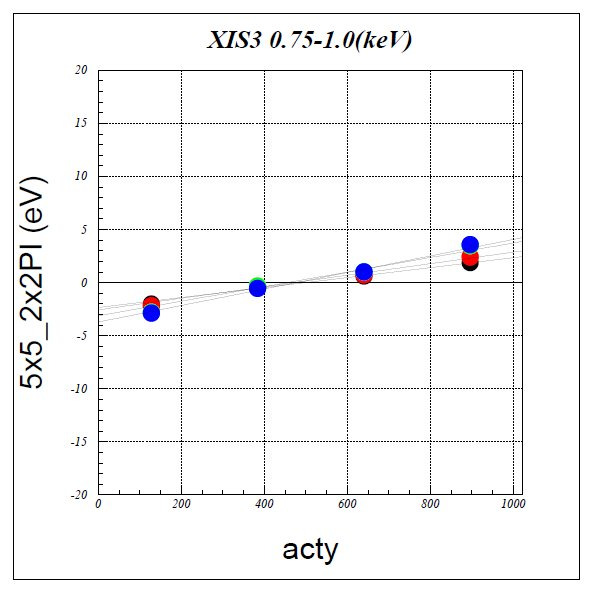
[XIS0, hard-band] 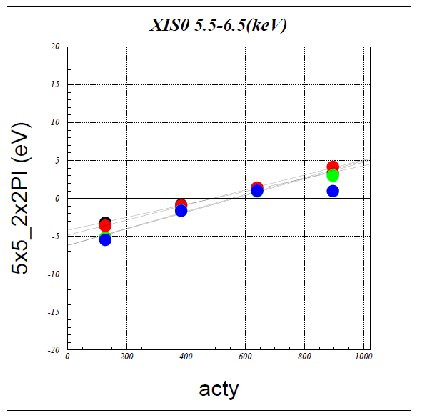
[XIS3, hard-band] 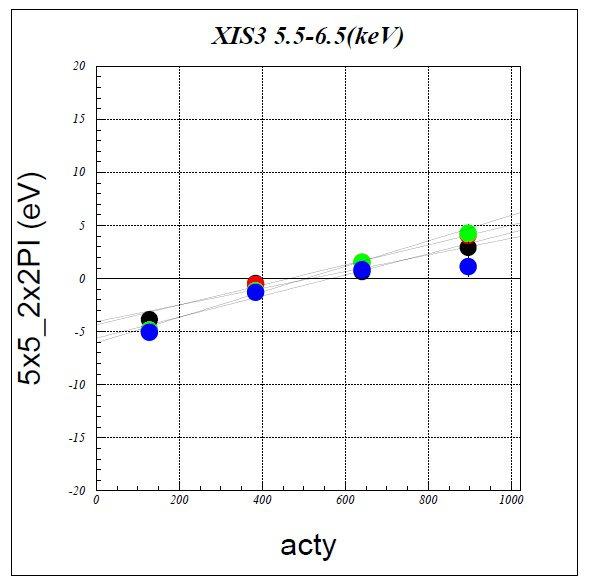
|
7.3.2.4 Energy Calibration Notes for Users & Proposers
Users can exploit the calibration results presented above by using the
xisrmfgen tool. Remaining issues include the following:
- Si K
- In all clocking/editing modes, uncertainties of the gain
and energy resolution calibration at the Si K edge remain prominent
for the FI devices. It is currently advised to remove data between
1.8 and 2.0keV from spectral fitting. For the BI device, a
workaround has been implemented in the CALDB in 2012 which
is mitigating this uncertainty.
- Au M
- Some uncertainties still remain in the Au M band, with Au
having been used for the surface coating of the mirrors. This is
visible for very bright sources. Users need to remove data taken in
the relevant energy band from spectral fitting.
- Al K
- Some uncertainties still remain in the Al K band, with Al
having been used for the electrodes in the CCD. This is visible for
very bright sources. Users need to remove data taken in the relevant
energy band from spectral fitting.
 10keV
10keV- The background level is higher than expected in the
energy band above
 10keV. The cause for this is not yet
identified.
10keV. The cause for this is not yet
identified.
7.3.3 Contamination & Low Energy Quantum Efficiency Degradation
The quantum efficiency below  2keV has been decreasing since
launch due to accumulation of contaminating material on the optical
blocking filter (OBF) of each sensor. The OBF is cooler than other
parts of the satellite, thus it is prone to the accumulation of
contamination. The contaminant consists of several different materials
with time-varying composition. The time dependence of the thickness
and the chemical composition of the contaminant at the XIS nominal
position are monitored and calibrated, as well as the spatial
dependence of the thickness across the field of view (Table 7.10).
2keV has been decreasing since
launch due to accumulation of contaminating material on the optical
blocking filter (OBF) of each sensor. The OBF is cooler than other
parts of the satellite, thus it is prone to the accumulation of
contamination. The contaminant consists of several different materials
with time-varying composition. The time dependence of the thickness
and the chemical composition of the contaminant at the XIS nominal
position are monitored and calibrated, as well as the spatial
dependence of the thickness across the field of view (Table 7.10).
7.3.3.1 Contamination Calibration Results
The chemical composition is modeled phenomenologically with
time-varying columns of H, C, N and O. Three calibration sources --
RXJ1856.5 3754 (a super-soft isolated neutron star),
PKS2155
3754 (a super-soft isolated neutron star),
PKS2155 304 (a blazar), and 1E0102.2
304 (a blazar), and 1E0102.2 7219 (a line-dominated
supernova remnant) -- are used to derive the chemical composition at
each epoch of the observations. The spectral models by
Burwitz et al. (2003) for RXJ1856.5
7219 (a line-dominated
supernova remnant) -- are used to derive the chemical composition at
each epoch of the observations. The spectral models by
Burwitz et al. (2003) for RXJ1856.5 3754, a simple power-law model for
PKS2155
3754, a simple power-law model for
PKS2155 304, and the model by Plucinsky et al. (2008) for
1E0102.2
304, and the model by Plucinsky et al. (2008) for
1E0102.2 7219 are used as standard
models. Fig. 7.20 shows the result of XIS1 fitting
for RXJ1856.5
7219 are used as standard
models. Fig. 7.20 shows the result of XIS1 fitting
for RXJ1856.5 3754 using the 2012 contamination model for selected
epochs.
3754 using the 2012 contamination model for selected
epochs.
Figure 7.20:
Results of
spectral fitting of the BI spectrum of RXJ1856.5 3754 with the
current contamination model at the XIS nominal position for
several different epochs.
3754 with the
current contamination model at the XIS nominal position for
several different epochs.
|
|
The time dependence of the thickness of the contaminant is modeled
with phenomenological functions of time, separately for each
composition and sensor. Fig. 7.21,
7.22, and 7.23 show the
evolution of the thickness for different elements, while
Fig. 7.24 shows the combined optical thickness and
the relative reduction of the effective area for two different
energies. The thickness increased rapidly for one year after launch
and continued to increase at a moderate pace thereafter. The N
component is used for the XIS1 only.
Figure 7.21:
Time
dependence of the C thickness at the XIS nominal position for each
sensor. Solid curves indicate the contamination model of
CALDB file ae_xi?_contami_20140825.fits .
|
|
Figure 7.22:
Time
dependence of the N thickness at the XIS nominal position for each
sensor. Solid curves indicate the contamination model of
CALDB file ae_xi?_contami_20140825.fits.
|
|
Figure 7.23:
Time
dependence of the O thickness at the XIS nominal position for each
sensor. Solid curves indicate the contamination model of
CALDB file ae_xi?_contami_20140825.fits.
|
|
Figure 7.24:
Top panel: Time dependence of the combined
optical depth - with the dashed lines representing the
contamination model of CALDB file
ae_xi?_contami_20140825.fits. Bottom panel:
Time dependence of the relative reduction of the effective area -
with the dashed lines representing linear fits and their
extrapolations.
|
|
The spatial distribution of the contaminants is monitored and
calibrated using regular observations of a part of the Cygnus Loop, a
thermal supernova remnant. The atmospheric fluorescent K lines of N I
and O I, which illuminate the entire field of view when the telescope
is oriented toward the day earth, are used as well. The model of the
spatial dependence assumes a radially symmetric pattern
(Koyama et al., 2007). The chemical composition and the thickness at the
center are normalized to the values presented in
Fig. 7.21, 7.22, and
7.23. Different sensors have different radial
profiles (Fig. 7.25).
Figure 7.25:
Spatial dependence of the thickness derived from day
earth observation data at different epochs. Open circles and
filled triangles represent the data points determined by the N and
O lines, respectively. The best fit models are shown as solid
curves.
|
|
7.3.3.2 Contamination Notes for Users & Proposers
The contaminant calibration results are available for use through the
ARF generation tools xissimarfgen (Ishisaki et al., 2007)
and xisarfgen. It is discouraged to use the generic
contamination models in the XSPEC package (e.g.,
xisabs, xiscoabs, xiscoabh,
xispcoab). For proposal writers ARF files are provided that
assume a contamination thickness extrapolated to the middle of the
next AO cycle, based on the current trend.
7.3.4 Non X-Ray Background
The Non X-ray Background (NXB) has several sources. The most dominant
source are events produced by ionization losses of charged cosmic ray
particles. Others include fluorescence X-rays from materials used in
the spacecraft and the  Fe calibration sources attached to the
door of each sensor (opened immediately after the launch). Most of the
NXB events are discarded onboard as grade 7 events. The NXB of the XIS
is known to be very stable on time scales of months and thus the NXB
spectrum can be constructed using data obtained when the spacecraft is
pointed toward the Earth at night. The NXB database is accessible as
part of the CALDB, which is updated biannually in June and
December.
Fe calibration sources attached to the
door of each sensor (opened immediately after the launch). Most of the
NXB events are discarded onboard as grade 7 events. The NXB of the XIS
is known to be very stable on time scales of months and thus the NXB
spectrum can be constructed using data obtained when the spacecraft is
pointed toward the Earth at night. The NXB database is accessible as
part of the CALDB, which is updated biannually in June and
December.
7.3.4.1 NXB Calibration Results
Fig. 7.26 shows the NXB spectrum for each sensor. The
background rate in the 0.4-12keV band is 0.1-0.2counts s for the FI CCDs and 0.3-0.6counts s
for the FI CCDs and 0.3-0.6counts s for the BI CCD after
grade selection. The background rate of XIS1 appears to become smaller
after increasing the injection charge amount from 2keV to 6keV
equivalent. The cause of this difference is currently under
investigation. Table 7.11 shows the current best estimates
for the strength of major XIS emission features, along with their 90%
confidence errors.
for the BI CCD after
grade selection. The background rate of XIS1 appears to become smaller
after increasing the injection charge amount from 2keV to 6keV
equivalent. The cause of this difference is currently under
investigation. Table 7.11 shows the current best estimates
for the strength of major XIS emission features, along with their 90%
confidence errors.
Figure 7.26:
Non X-ray
background (NXB) rate for XIS0 (black), XIS1 (red), and XIS3
(blue). The spectra are constructed from night Earth
observations.
|
|
Table 7.11:
Strength of
conspicuous emission lines in the NXB spectrum. The count rates
are obtained from the entire CCD chip except for the corners
irradiated by the calibration source. The errors are the 90%
statistical uncertainties (Tawa et al., 2008).
| Line |
Energy |
XIS0 |
XIS1 |
XIS2 |
XIS3 |
| |
[keV] |
[ cps/pix] cps/pix] |
[ cps/pix] cps/pix] |
[ cps/pix] cps/pix] |
[ cps/pix] cps/pix] |
Al K |
1.486 |
 |
 |
 |
 |
Si K |
1.740 |
 |
 |
 |
 |
Au M |
2.123 |
 |
 |
 |
 |
Mn K |
5.895 |
 |
 |
 |
 |
Mn K |
6.490 |
 |
 |
 |
 |
Ni K |
7.470 |
 |
 |
 |
 |
Ni K |
8.265 |
 |
 |
 |
 |
Au L |
9.671 |
 |
 |
 |
 |
Au L |
11.51 |
 |
 |
 |
 |
The total intensity of the NXB depends strongly on the geomagnetic
cut-off rigidity (COR), as the dominant source of the background
originates from cosmic rays. Fig. 7.27 shows the
NXB count rate as a function of the COR. The ftool
xisnxbgen generates NXB spectra for an observation
in such a way that the histogram of the COR is the same between the
observation of the source and the night Earth observations. The night
Earth data are retrieved from  150 days of the observation of the
source by default. The PIN's Upper Discriminator (PIN-UD) count rate
is also useful as a proxy for the COR, and thus the XIS NXB
level. Tawa et al. (2008) show that the PIN-UD provides a slightly better
reproducibility of the XIS NXB than the COR. The reproducibility of
the NXB in the 5-12keV band is evaluated to be 3-4% of the NXB,
when the PIN-UD is used as the NXB sorting parameter.
150 days of the observation of the
source by default. The PIN's Upper Discriminator (PIN-UD) count rate
is also useful as a proxy for the COR, and thus the XIS NXB
level. Tawa et al. (2008) show that the PIN-UD provides a slightly better
reproducibility of the XIS NXB than the COR. The reproducibility of
the NXB in the 5-12keV band is evaluated to be 3-4% of the NXB,
when the PIN-UD is used as the NXB sorting parameter.
Figure 7.27:
Cut-off rigidity
dependence of the NXB (average intensity for 5-10keV) for each
sensor. The NXB flux varies by a factor of  2 depending on
the cut-off rigidity.
2 depending on
the cut-off rigidity.
|
|
The NXB is not uniform over the chip. It is stronger toward larger
ACTY positions (Fig. 7.28). This is because some
fraction of the NXB is produced in the frame-store region. The
fraction can be different between the fluorescent lines and the
continuum.
Figure 7.28:
ACTY dependence of the NXB for
XIS0, XIS1, and XIS3. Black lines indicate the continuum component
(2.5-5.5keV), while the red lines indicate the Ni K line component (7.2-7.8keV). The NXB flux tends to be higher at
larger ACTY, because some fraction of the NXB is produced in the
frame store region.
line component (7.2-7.8keV). The NXB flux tends to be higher at
larger ACTY, because some fraction of the NXB is produced in the
frame store region.
|
|
The NXB level changes both continuously and discontinuously. The
continuous changes are seen only in the low energy band for the BI
sensor, in which a gradual increase in the NXB level is observed
(Figure 7.29), although the NXB level once
discontinuously decreased at the time when the injection charge was
increased. The level is stable for the high energy band for the BI and
the total band for the FI sensors.
Figure 7.29:
NXB spectrum of XIS1 integrated
over one year for CI 2keV (top) and CI
2keV (top) and CI 6keV (bottom). For
the CI
6keV (bottom). For
the CI 6 keV data, the second trailing rows are removed.
6 keV data, the second trailing rows are removed.
|
|
7.3.4.2 NXB Notes for Users & Proposers
A putative micro-meteorite hit occurred for XIS0 in 2009-06-23. Since
then, the XIS0 has been operated with an area discriminator masking
the damaged area. In the masked area, the NXB level is zero, which
causes an apparent discontinuous change in the NXB database. Users
generating their own NXB spectrum using xisnxbgen
need to be aware that they are mixing the NXB data before and after
the event if their observations are within  150 days of the event
(between January 24, 2009 and June 27, 2009). A recipe for mitigating
this is described at
150 days of the event
(between January 24, 2009 and June 27, 2009). A recipe for mitigating
this is described at
http://www.astro.isas.jaxa.jp/suzaku/analysis/xis/xis0_area_discriminaion/.
The SCI level was increased from 2 to 6keV in 2010. Due to the
increased amount of charges, the NXB level has increased
discontinuously. The increase is only seen in the second trailing rows,
which are the over-next rows from the rows with charge injection. Users
can achieve the same NXB level as for SCI 2keV by masking
events from the second trailing row1s. Details can be found at
2keV by masking
events from the second trailing row1s. Details can be found at
http://www.astro.isas.jaxa.jp/suzaku/analysis/xis/xis1_ci_6_nxb/.
When the XIS field of view is close to the day Earth (i.e., Sun-lit
Earth), fluorescent lines from the atmosphere contaminate the
low energy part of the XIS data, especially for the BI chip. Most
prominent are the O and N lines. Although the standard event screening
criterion (elevation angle from the day Earth  20degrees) is
sufficient to remove these features, some emission may remain due to
the variable nature of the Earth's X-ray albedo. In this case, event
screening with a higher elevation angle is recommended.
20degrees) is
sufficient to remove these features, some emission may remain due to
the variable nature of the Earth's X-ray albedo. In this case, event
screening with a higher elevation angle is recommended.
7.3.5 Flux Calibration
The stability of the relative normalization between the three XIS
sensors is shown in Fig. 7.30. No significant
change with time is found. The relative normalization remains
constant. The mean and standard deviation are summarized in
Table 7.12 separately for the XIS and HXD nominal
positions.
Figure 7.30:
Relative flux normalization among different sensors. The
ratio of the best-fit normalization values are compared between
different combinations of two sensors, at the XIS and the HXD
nominal positions. Observations of a power-law source in the Normal
clocking mode were used. The average values are shown with solid
lines.
|
|
Table 7.12:
Relative normalization among different sensors.
| Position |
Ratio |
Mean |
Standard deviation |
| XIS-norm |
XIS1/XIS0 |
1.026 |
0.016 |
| |
XIS3/XIS0 |
1.014 |
0.017 |
| HXD-norm |
XIS1/XIS0 |
1.004 |
0.019 |
| |
XIS3/XIS0 |
0.980 |
0.022 |
7.3.6 Putative Micro-Meteorite Hits
Sudden anomalies caused putatively by micro-meteorite hits have
affected XIS0, XIS1, and XIS2. The entire XIS2 was lost in 2006. A
part of the XIS0 was lost in 2009, which is masked by area
discrimination since then. A very small hole was created in the
optical blocking filter for the XIS1, but the sensor remains intact.
The anomaly of XIS2 suddenly occurred on Nov. 9, 2006, 1:03 UT.
About 2/3 of the image was flooded with a large amount of charge,
which had leaked somewhere in the imaging region. When the anomaly
occurred, the satellite was out of the SAA and the XIS sensors were
conducting observations in the Normal mode (SCI on, without any
options). Various tests to check the condition of XIS2 revealed that
(1) the four readout nodes of the CCD and the corresponding analog
chain were all working fine, (2) the charge injection was not directly
related to the anomaly, but may have helped to spread the leaked
charge. When the clock voltages were changed in the imaging region,
the amount of leaked charge changed as well. This indicates a short
between the electrodes and the buried channel. Possible mechanisms to
cause the short include a micro-meteoroite impact on the CCD, as seen,
e.g., on XMM-Newton and Swift. Although there is no
direct evidence to indicate an micro-meteoroite impact, the phenomenon
observed for XIS2 is not very different from what is expected from such
an event. The low-earth orbit and the low-grazing-angle mirrors of
Suzaku may have enhanced the probability of a micro-meteoroite
impact. An attempt to reduce the leaked charge by changing the clock
pattern and voltages in the imaging region was not
successful. Therefore it was decided to stop operating the sensor. It
is unlikely that operation of the XIS2 will be resumed in the
future. More details can be found at
http://www.astro.isas.jaxa.jp/suzaku/doc/suzakumemo/suzakumemo-2007-08.pdf.
XIS0 suddenly showed an anomaly on June 23, 2:00 UT. During Normal
clocking operations, a part of segment A of XIS0 was flooded with a
large amount of charges, which caused saturation of the analog
electronics. The anomaly was very similar to that which occurred in
the XIS2 in 2007. It is therefore suspected that both anomalies have
the same origin, possibly a micro-meteorite impact.The effect is
confined to 1/8 of the area of XIS0. The XIS team continues to operate
XIS0. Users need to be aware of several remaining artifacts after the
event:. In the Psum clocking mode, the effect spreads to the entire
XIS0 with severe data degradation. The XIS team discontinues the use
of Psum clocking mode for the XIS0. More details can be found
at
http://www.astro.isas.jaxa.jp/suzaku/doc/suzakumemo/suzakumemo-2010-01.pdf.
XIS1 suddenly showed an anomaly some time between Dec 18, 2009 12:50
UT and 14:10 UT. A bright and persistent spot suddenly appeared at one
end of segment C in all images taken during day Earth observations,
while none was found during night Earth observations. It is speculated
that the anomaly stems from optical light leaked from a hole with a
size of  7.5
7.5 m in the optical blocking filter created by a
micro-meteorite hit. From diagnostic observations, it was concluded
that the scientific impact of this anomaly is minimal. XIS1 has been
and will be operated in the same way as before the anomaly. More
details can be found at
m in the optical blocking filter created by a
micro-meteorite hit. From diagnostic observations, it was concluded
that the scientific impact of this anomaly is minimal. XIS1 has been
and will be operated in the same way as before the anomaly. More
details can be found at
http://www.astro.isas.jaxa.jp/suzaku/doc/suzakumemo/suzakumemo-2010-03v2.pdf.
We obtained some frame dump images of the day Earth in 2013, July 16,
and found a total of 10 new bright spots on XIS1 and XIS3. We
speculate that they are caused by OBF holes for their similarities
with the event in 2009 December for XIS1. The sizes of the OBF holes
are estimated to be very small,  0.3 pixels, so they are expected
to have no effect on the X-ray data unless an optically bright source
coincidently falls onto one of the holes. More details can be found
at
0.3 pixels, so they are expected
to have no effect on the X-ray data unless an optically bright source
coincidently falls onto one of the holes. More details can be found
at
http://www.astro.isas.jaxa.jp/suzaku/doc/suzakumemo/suzakumemo-2013-01.pdf.
7.4 XIS Onboard Processing
7.4.1 Pulse Height Determination & Hot Pixel Rejection
When a CCD pixel absorbs an X-ray photon, the X-ray is converted to an
electric charge, which in turn produces a voltage at the analog output
of the CCD. This voltage (``pulse height'') is proportional to the
energy of the incident X-ray. In order to determine the true pulse
height corresponding to the input X-ray energy, it is necessary to
subtract the dark levels and correct possible optical
light leaks.
Dark levels are non-zero pixel pulse heights caused by leakage
currents in the CCD. In addition, optical and UV light might enter the
sensor due to imperfect shielding (``light leak''), producing pulse
heights that are not related to X-rays. The analysis of ASCA
SIS data, which utilized an X-ray CCD in photon-counting mode for the
first time, showed that the dark levels were different from pixel to
pixel, and the distribution of the dark level did not necessarily
follow a Gaussian function. On the other hand, light leaks are
considered to be rather uniform over the CCD.
For the Suzaku XIS, the dark levels and the light leaks are calculated
separately in the Normal mode. The dark levels are defined for each
pixel and are expected to be constant for a given observation. The PPU
calculates the dark levels in the Dark Initial operation; those are
stored in the Dark Level RAM. The average dark level is determined for
each pixel, and if the dark level is higher than the hot-pixel
threshold, this pixel is labeled as a hot pixel. The dark
levels can be updated by the Dark Update operation, and sent to the
telemetry by the Dark Frame mode. The analysis of ASCA data
showed that the dark levels tend to change mostly during the SAA
passage of the satellite. The Dark Update operation is conducted after
every SAA passages unless the telescope is pointed toward the day
Earth.
Hot pixels are pixels which always output pulse heights larger than
the hot-pixel threshold even without input signals. Hot pixels are not
usable for observations, and their output has to be disregarded during
scientific analysis. The XIS detects hot pixels on-board by the Dark
Initial/Update mode, and their positions are registered in the Dark
Level RAM. Thus, hot pixels can be recognized on-board, and they are
excluded from the event detection processes. It is also possible to
specify hot pixels manually. However, some pixels output pulse heights
larger than the threshold intermittently. Such pixels are called
flickering pixels. It is difficult to identify and remove flickering
pixels on board. They are inevitably included in the telemetry and
need to be removed in scientific analysis, for example by using the
FTOOLS sisclean. Flickering pixels sometimes cluster
around specific columns, which makes them relatively easy to identify.
The light leaks are calculated on board from the pulse height data
after subtraction of the dark levels. A truncated average is
calculated for  pixels (this size was
pixels (this size was  before January 18, 2006) in every exposure and its running average
produces the light leak. In spite of the name, light leaks do not
represent in reality optical/UV light leaks in the CCD. They mostly
represent fluctuation of the CCD output correlated to the variations
of the satellite bus voltage. The XIS has little optical/UV light
leak,it is negligible unless the bright earth comes close to the XIS
field of view.
before January 18, 2006) in every exposure and its running average
produces the light leak. In spite of the name, light leaks do not
represent in reality optical/UV light leaks in the CCD. They mostly
represent fluctuation of the CCD output correlated to the variations
of the satellite bus voltage. The XIS has little optical/UV light
leak,it is negligible unless the bright earth comes close to the XIS
field of view.
The dark levels and the light leaks are merged in the Parallel-sum
(P-Sum) mode, so the Dark Update mode is not available in the P-Sum
mode. The dark levels, which are defined for each pixel as in the case
of the Normal mode, are updated every exposure. It may be considered
that the light leak is defined for each pixel in the P-Sum mode.
7.4.2 On-Board Event Analysis
The main purpose of the on-board processing of the CCD data is to
reduce the total amount of data transmitted to the ground. For this
purpose, the PPU searches for a characteristic pattern of the charge
distribution (called an event) in the pre-processed (post dark level
and light leak subtraction) frame data. When an X-ray photon is
absorbed in a pixel, the photo-ionized electrons can spread into at
most four adjacent pixels.
An event is recognized when a pixel has a pulse height which is
between the lower and the upper event thresholds and is larger than
those of eight adjacent pixels (e.g., it is the peak value in the
 pixel grid). In the P-Sum mode, only the horizontally
adjacent pixels are considered. The copied and the dummy pixels ensure
that the event search is enabled on the pixels at the edges of each
segment. The RAW XY coordinates of the central pixel are considered
the location of the event. Pulse-height data for the adjacent
pixel grid). In the P-Sum mode, only the horizontally
adjacent pixels are considered. The copied and the dummy pixels ensure
that the event search is enabled on the pixels at the edges of each
segment. The RAW XY coordinates of the central pixel are considered
the location of the event. Pulse-height data for the adjacent  square pixels (or three horizontal pixels in the P-Sum mode)
are sent to the Event RAM as well as the pixel location.
square pixels (or three horizontal pixels in the P-Sum mode)
are sent to the Event RAM as well as the pixel location.
The MPU reads the Event RAM and edits the data to the telemetry
format. The amount of information sent to the telemetry depends on the
editing mode of the XIS. All the editing modes are designed to send
the pulse heights of at least four pixels of an event to the
telemetry, because the charge cloud produced by an X-ray photon can
spread into at most four pixels. Information of the surrounding pixels
may or may not be output to the telemetry depending on the editing
mode. The  mode outputs the most detailed information to the
telemetry, i.e., all 25 pulse-heights from the
mode outputs the most detailed information to the
telemetry, i.e., all 25 pulse-heights from the  pixels
containing the event. The size of the telemetry data per event is
reduced by a factor of two in the
pixels
containing the event. The size of the telemetry data per event is
reduced by a factor of two in the  mode, and another factor
of two in the
mode, and another factor
of two in the  mode. Details of the pulse height information
sent to the telemetry are described in the next section.
mode. Details of the pulse height information
sent to the telemetry are described in the next section.
7.4.3 Discriminators
Three kinds of discriminators, area, grade, and class discriminators,
can be applied during the on-board processing. The grade discriminator
is available only in the Timing mode. The class discriminator was
implemented after the launch of Suzaku and was used since January,
2006. In most cases, guest observers need not change the default
setting of these discriminators.
The class discriminator classifies the events into two classes,
``X-rays'' and ``others,'' and outputs only the "X-ray" class to the
telemetry when it is enabled. This class discriminator is always
enabled to reduce the telemetry usage of non-X-ray events. The
``other'' class is close to, but slightly different from the ASCA
grade 7. When the XIS points to a blank sky, more than 90% of the
detected events are particle events (mostly corresponding to ASCA
grade 7 events). If we reject these particle events on board, we can
make a substantial saving in the telemetry usage. This is especially
useful when the data rate is medium or low. The class discriminator
realizes such a function in a simple manner. When all the eight pixels
surrounding the event center exceed the Inner Split Threshold, the
event is classified as from the ``other'' class, and the rest of the
events as from the ``X-ray'' class. With such a simple method, we can
reject more than three quarters of the particle events. The class
discriminator works only for the  and
and  modes. It is not available in the
modes. It is not available in the  mode and the timing
mode.
mode and the timing
mode.
Fig. 7.5 shows the pixel pattern for which the pulse
height or 1-bit information is sent to the telemetry. We do not assign
grades to an event on board in the Normal Clock mode. This means that
a dark frame error, if present, can be corrected accurately during
ground processing even in the 2  2 mode. The definition of the
grades in the P-Sum mode is shown in Fig. 7.31.
2 mode. The definition of the
grades in the P-Sum mode is shown in Fig. 7.31.
Figure 7.31:
Definition
of grades in the P-Sum/Timing mode. Total pulse height and the
grade of the event are output to the telemetry. Note that the
grades are defined referring to the direction of the serial
transfer, so the central pixel of the grade 1 event has a
larger RAW-X value than the second pixel, while the
opposite is true for the grade 2 event.
|
|




Next: Bibliography
Up: Suzaku Technical Description
Previous: 6. X-Ray Telescopes (XRT)
Contents
Katja Pottschmidt
2015-01-27
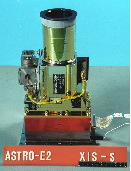

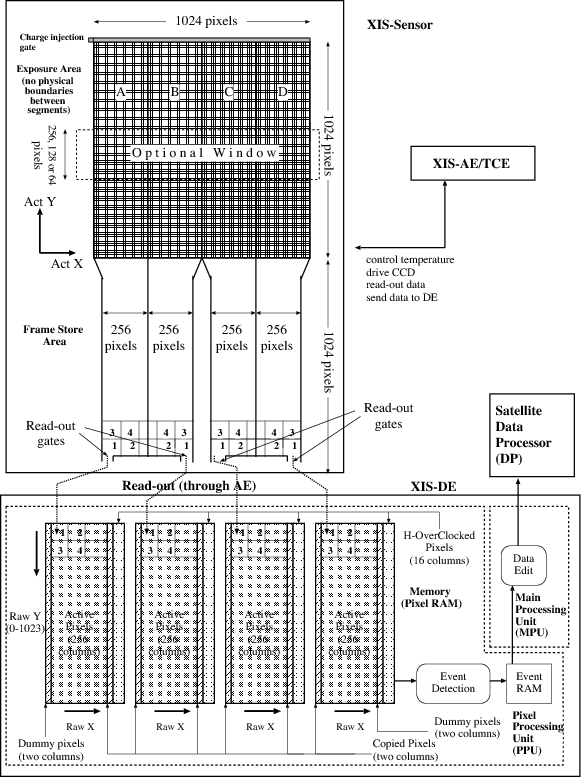
![\begin{landscape}
% latex2html id marker 2868\begin{table}[hp]
\centering
\...
...ased for damaged area.\\
%
\hline
\end{longtable} \end{table}\end{landscape}](img149.png)

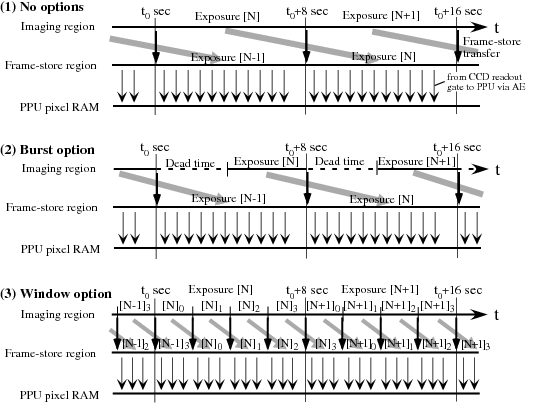





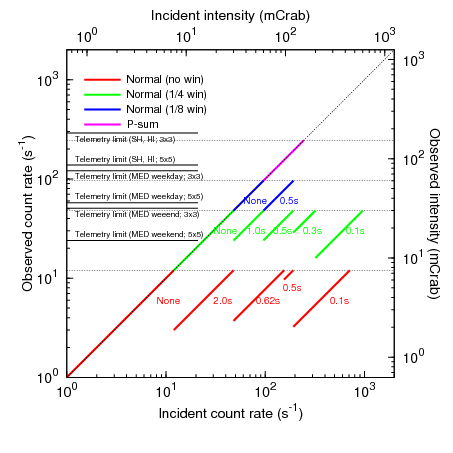


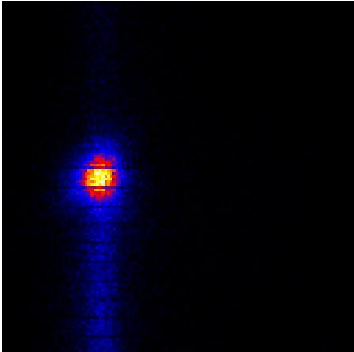
![\begin{landscape}
% latex2html id marker 3212\begin{table}[p]
\centering
\c...
...d{footnotesize} \end{tablenotes} \end{threeparttable} \end{table}\end{landscape}](img188.png)

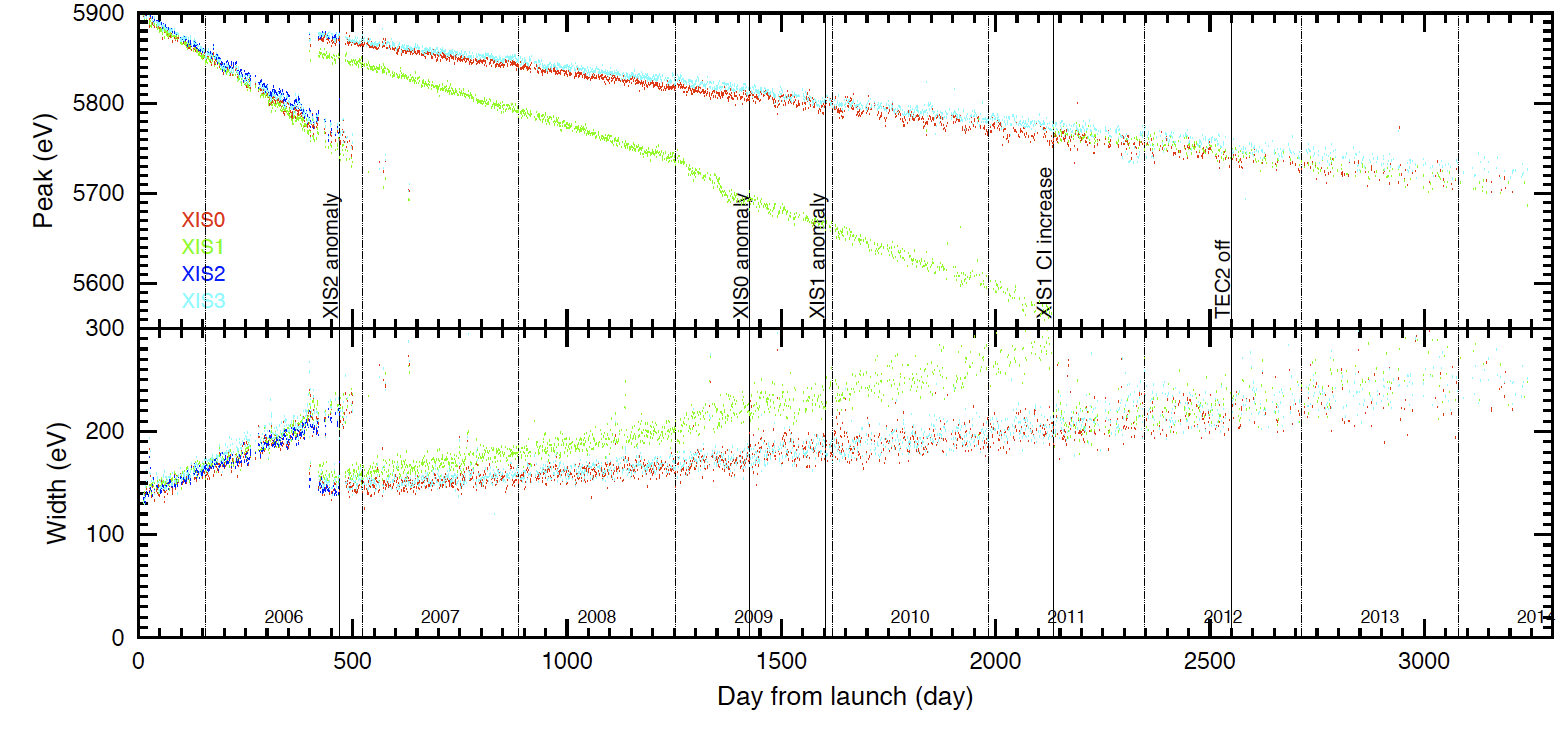
![\includegraphics[width=1.00\textwidth]{figures_xis/fig10_MnKaCenter}](img195.png)
![\includegraphics[width=1.00\textwidth]{figures_xis/fig11_MnKaWidth}](img196.png)
![\includegraphics[width=1.00\textwidth]{figures_xis/fig12_OLyaCenter}](img197.png)
![\includegraphics[width=1.00\textwidth]{figures_xis/fig13_OLyaWidth}](img198.png)
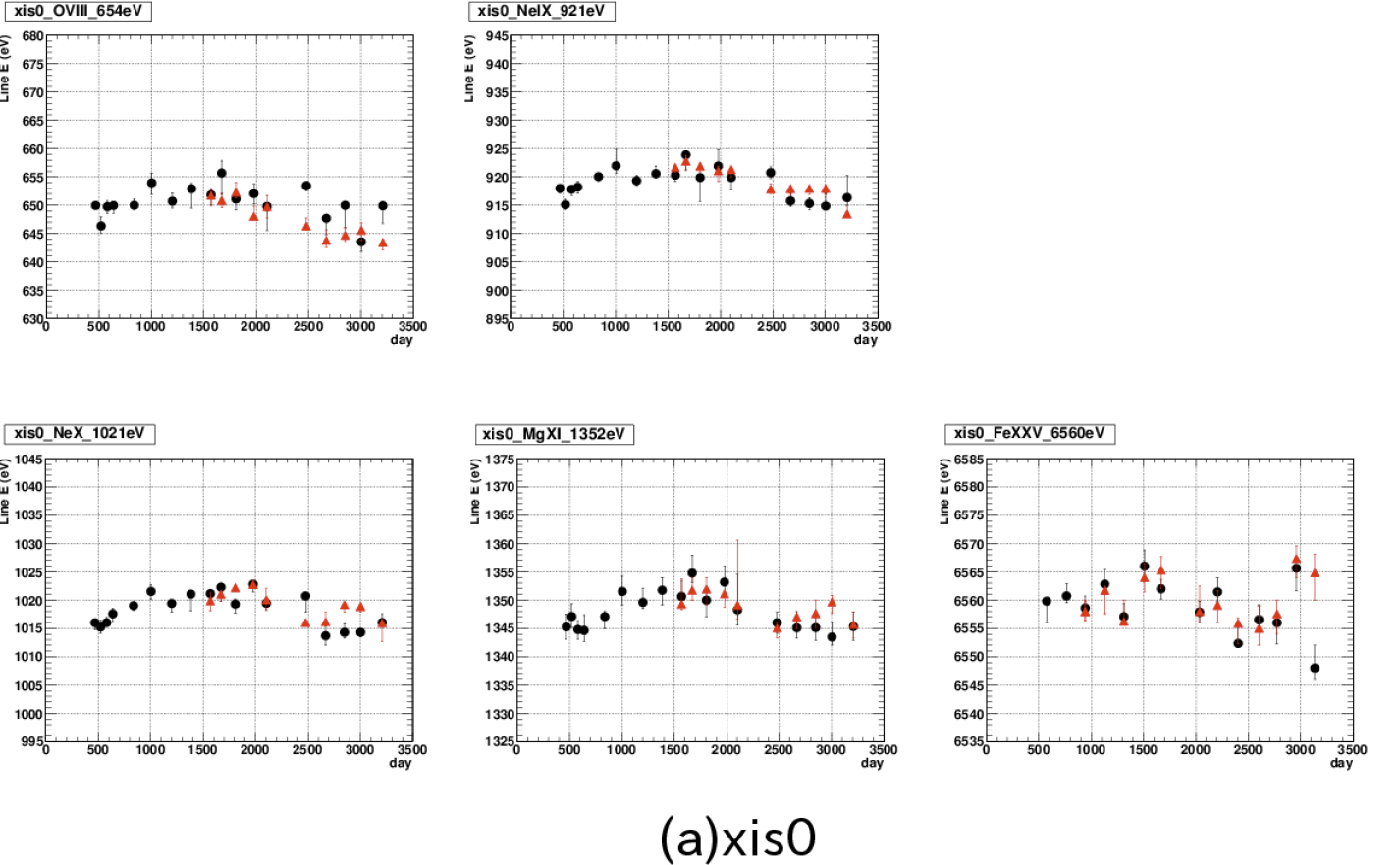
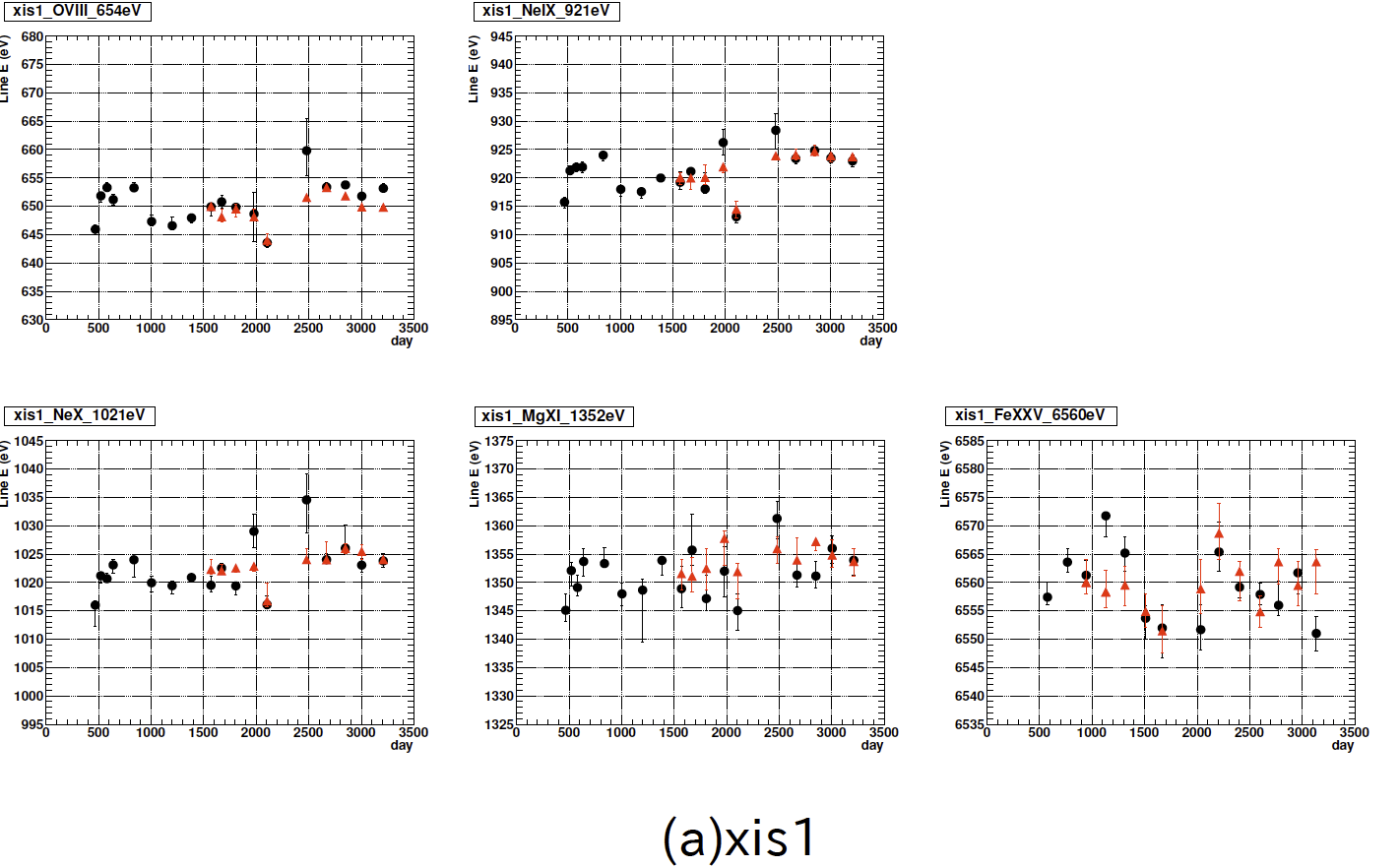
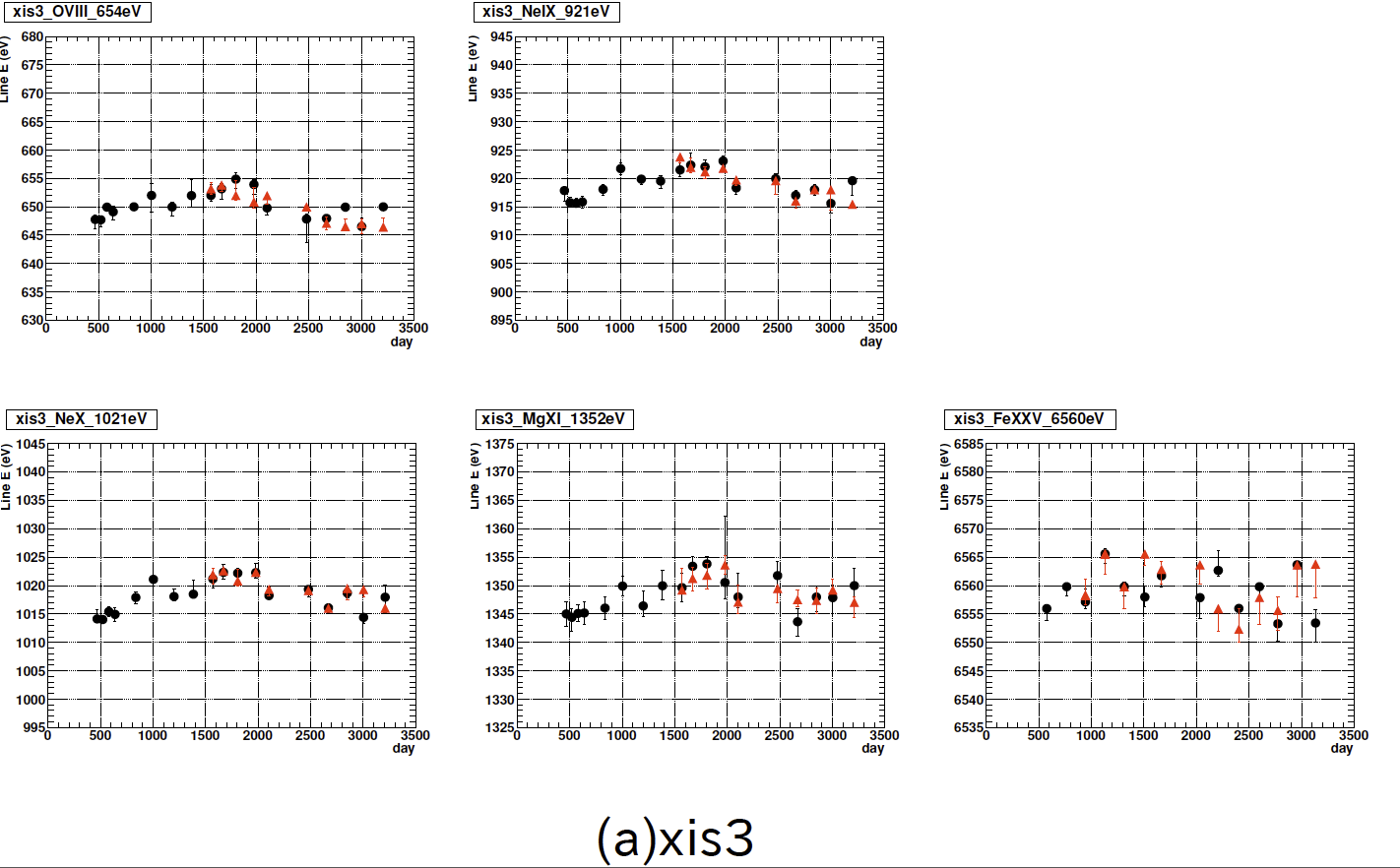

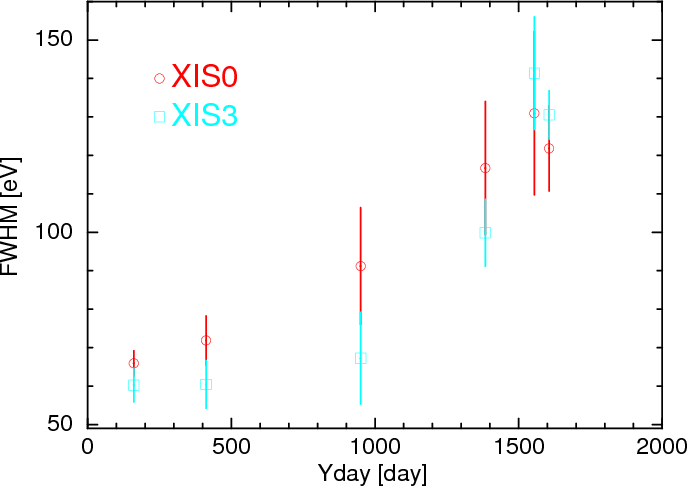
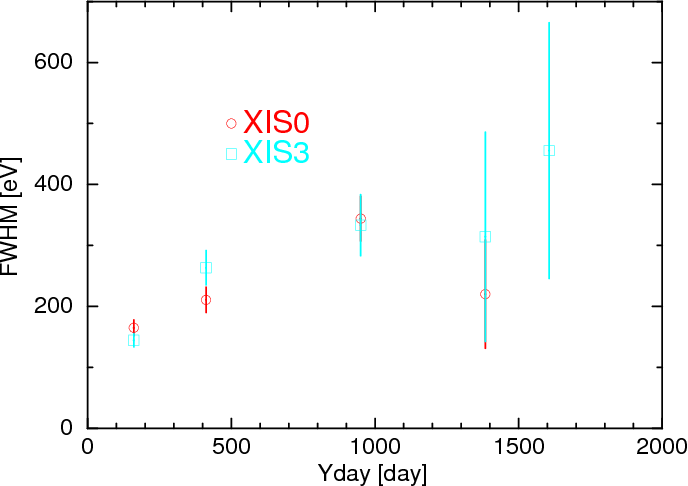
 [XIS3, soft-band]
[XIS3, soft-band] [XIS0, hard-band]
[XIS0, hard-band] [XIS3, hard-band]
[XIS3, hard-band]
